 ?Mathematical formulae have been encoded as MathML and are displayed in this HTML version using MathJax in order to improve their display. Uncheck the box to turn MathJax off. This feature requires Javascript. Click on a formula to zoom.
?Mathematical formulae have been encoded as MathML and are displayed in this HTML version using MathJax in order to improve their display. Uncheck the box to turn MathJax off. This feature requires Javascript. Click on a formula to zoom.Abstract
The five Starra iron oxide copper–gold (IOCG) deposits, which are located in the Cloncurry district of the Mount Isa Inlier, NW Queensland, are hosted in a N-trending zone of deformed iron-rich metasedimentary rocks that are underlain by two mineralogically distinct mafic–intermediate meta-igneous rocks. Copper–Au mineralisation is subdivided into two stages—an early main stage that transitioned from a magnetite-dominated Cu substage comprising chalcopyrite, pyrite, biotite and chlorite, to a hematite–muscovite-bearing Cu–Au substage with chalcopyrite, bornite and rare chalcocite, as well as Au–Ag-tellurides and native Au. This second stage was followed by a subordinate but nonetheless important carbonate–quartz–barite vein stage with minor but locally high-grade Cu–Au mineralisation characterised by abundant chalcocite and bornite, minor native bismuth and wittichenite (Cu3BiS3), together with minor Au–Ag telluride minerals. Bornite in these carbonate–quartz–barite veins contains considerable amounts of Au (>10 ppm), which appears to be deported either as lattice substitution in the bornite crystal structure or as homogeneously distributed Au0 nanoparticles. An earlier, coarse-grained mafic intrusion was affected by early Na–Ca alteration, whereas a second mafic intrusion lacks evidence of Na–Ca alteration but was exposed to K–Fe alteration and subsequent mineralisation at Starra 222. Mushketovite (magnetite after specular hematite) is only observed in ironstone lodes proximal to the mafic–intermediate rocks. The close spatial and mineralogical associations of the mafic–intermediate bodies and the ironstone lodes point to a stronger link between magmatic activity and IOCG mineralisation than has previously been recognised at Starra. Remobilisation of gold by late-stage hydrothermal fluids aided by the relatively low fluid temperatures during the main pulse of Cu–Au mineralisation refined gold grades at Starra, making it a relatively gold-rich IOCG deposit. We show that the Cu–Au deposits of the Starra trend feature mineralogical and geochemical elements common to both Cloncurry IOCG deposits (e.g. abundant magnetite) and IOCG deposits of the Tennant Creek district (e.g. Au–Cu–Bi mineralisation; hematite–bornite–chalcocite assemblages), making them a unique and important member of this complex family of deposits.
KEY POINTS
Mafic–intermediate sills below Starra ore deposits indicate a potential link between magmatic activity and IOCG mineralisation.
Mushketovite associated with chalcopyrite mineralisation indicates that the mineralising fluid was initially reduced.
Different radiogenic Pb isotope compositions in Cu sulfides, hematite and calcite require multiple Pb sources, which is consistent with distinct fluids.
Introduction
Iron oxide copper–gold (IOCG) deposits are hydrothermal Cu–Au systems characterised chiefly by the presence of abundant iron oxides (i.e. hematite and/or magnetite) rather than iron sulfides (i.e. pyrite), as occurs in porphyry deposits (Groves et al., Citation2010; Porter, Citation2000; Skirrow, Citation2022a; Williams et al., Citation2005). Since its recognition in the early 1990s, the IOCG deposit class has been hampered by a lack of coherence on multiple fronts, such as an agreed fluid source, structural/geodynamic setting, relationship to magmatic rocks, and predominant ore and alteration mineralogy (Barton et al., Citation2000; Barton & Johnson, Citation1996; Hitzman et al., Citation1992; Oreskes & Einaudi, Citation1992; Pollard, Citation2006). One reason for this is the inclusion of deposits in the class that exhibit one or more features considered to be fundamental (e.g. predominantly Fe-oxide gangue) but are poor fits according to most other criteria, such as lack of sulfide mineralisation or highly variable Cu grades (<0.1 to 10 wt% Cu) and Au grades (<0.5 to >10 g/t; Groves et al., Citation2010). A second reason is the empirical commonality in mineral assemblages between IOCG deposits and those belonging to the iron oxide–apatite (IOA) or Kiruna-type class, which has bred speculation that these two classes may in fact be genetically linked (e.g. Real et al., Citation2020; Reich et al., Citation2016; Rodriguez-Mustafa et al., Citation2020; Sillitoe, Citation2003; Simon et al., Citation2018). Third, some researchers have noted the broad similarities in geodynamic setting and mineralogy between porphyry Cu–Au–Mo deposits and IOCGs in certain provinces (Tornos et al., Citation2010), whereas others have posited a continuum between these two classes (Richards & Mumin, Citation2013a, Citation2013b). Moreover, much of the impetus for genetically linking IOCG deposits to either IOA or porphyry deposits arises from the unique geological and structural setting of western South America, particularly the Coastal Cordillera of northern Chile and southern Peru. The virtually undeformed and unmetamorphosed nature of all ore deposits in this region has helped clarify some aspects of IOCG genesis but has also left other issues unresolved (e.g. Escolme et al., Citation2020; Mateo et al., Citation2023).
Older and less pristine IOCG districts—such as those located in Australia, Brazil and northern Sweden—have not received as much attention in the latter space owing to the difficulties in distinguishing hydrothermal alteration from regional metamorphic mineral assemblages, as well as obscured or obliterated primary structural or stratigraphic relationships between ores and host rocks. The Eastern Fold Belt of the Mount Isa Inlier, northwest Queensland (), contains one such district, Cloncurry, which hosts more than 20 IOCG deposits and prospects, including Ernest Henry, one of the largest IOCG systems in Australia (Williams et al., Citation1998). Significant work on the origins of these systems was conducted in the late 20th and early 21st centuries by numerous researchers (e.g. Adshead, Citation1995; Adshead-Bell, Citation1998; Baker, Citation1998; Cannell & Davidson, Citation1998; Davidson, Citation1989; Mark et al., Citation2006; Oliver et al., Citation2008; Rotherham et al., Citation1998; Rusk et al., Citation2010; Twyerould, Citation1997). More recently, Duncan et al. (Citation2011, Citation2014) examined the structural and geochronological relationships of IOCG systems in the Selwyn corridor, located in the southern Cloncurry district. Several studies focused on the deposits of the Starra trend and proposed contrasting models for the origin of the Cu–Au mineralisation there based on independent observations and techniques (Davidson, Citation1989; Davidson & Large, Citation1994; Rotherham et al., Citation1998).
Figure 1. (a) Geographical location of the Mount Isa Inlier in northern Australia, highlighting the three main orogenic belts. (b) Geological map showing the main lithological units of the Eastern Fold Belt (EFB). The Starra deposits are in the southern part of the EFB (after Gibson et al., Citation2016).
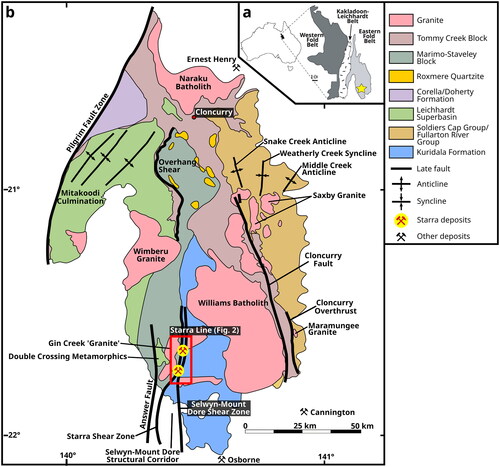
Here, we present new petrographic and geochemical data on a suite of samples from all five Starra deposits, including LA-ICPMS trace-element images of Cu sulfides (bornite and chalcopyrite) as well as hematite and magnetite. We demonstrate that the mafic–intermediate meta-igneous rocks that form the footwall of the mineralised trend are themselves mineralised, with identical ore and alteration assemblages to those seen in the host ironstones. These relationships were not previously recognised, but their existence lends credence to previous studies that have postulated a magmatic component to the ore fluids of many IOCG systems in the Cloncurry district (Kendrick et al., Citation2007, Citation2008; Oliver et al., Citation2004). They also make a direct link between magmatism and IOCG ore formation easier to substantiate, which has not been the case previously at Starra, whereas recent studies in the Carajás province have proposed a similar relationship between mineralisation and primitive magmatism (Perelló et al., Citation2023).
Starra: historical background and previous research
The Starra deposits were discovered in 1975 (Kary & Harley, Citation1990), and some of the early models for their formation invoked syn-sedimentary exhalative processes for the widespread hematite–magnetite bodies, referred to locally as ironstones. In this scenario, the oxidation of magnetite to hematite within the ironstones and the Cu–Au mineralisation were both the result of oxidised brines encountering a reduced rock package, like that described for SEDEX Zn–Pb–Ag deposits (Cooke et al., Citation2000; Davidson, Citation1989, Citation1992; Davidson & Large, Citation1994). An epigenetic model for the Starra deposits was first proposed by Switzer et al. (Citation1988) and expanded on by Rotherham (Citation1997), who argued for a single, magmatic-derived fluid that formed both the ironstones and subsequent Cu–Au mineralisation. Importantly, both the syngenetic and epigenetic models agree that the initially magnetite-rich ironstones served as reductants of an oxidised mineralising fluid. δ34S isotope values obtained from pyrite, chalcopyrite, bornite, chalcocite, barite and anhydrite by Rotherham et al. (Citation1998) display a wide range (–14.6 to +30.6‰ VCDT), which the authors explained by sulfide oxidation from a single fluid. Detailed fluid inclusion studies revealed the presence of multiple, high-salinity fluids at Starra during mineralisation (Williams et al., Citation2001). A fluid mixing model for Starra was also favoured by Baker et al. (Citation2008), which included magmatic-derived Cu-bearing fluids that were channelled along large-scale structures, and a non-magmatic fluid with an evaporite-like signature.
Multiple attempts have been made to date the main Cu–Au mineralisation event in the Starra system. An 40Ar/39Ar age obtained from biotite yielded a minimum mineralisation age of ca 1503 Ma (Perkins & Wyborn, Citation1998). More recently, a metamorphic origin of the mineralising fluid at Starra was proposed, based on high-precision U–Pb ages obtained from Na–Ca alteration and mineralised ironstone (Duncan et al., Citation2011) and textural observations (Duncan et al., Citation2014). Based on a U–Pb titanite age of 1594 ± 8 Ma, Duncan et al. (Citation2011) interpreted the Na–Ca alteration to be early syn-metamorphic in timing (i.e. synchronous with the D2 thermal peak of the Isan Orogeny). Rhenium–Os ages obtained from molybdenite yielded ages for the Starra mineralisation of 1568 ± 7 Ma (Duncan et al., Citation2011). The molybdenite mineralisation is associated with quartz, calcite, iron oxides and bornite, and as such was interpreted to have formed during the main mineralisation event at Starra. Since neither age can be linked definitively to an igneous event, the authors inferred a metamorphic fluid source. Other authors have allowed for the possibility that metamorphic fluids in the Cloncurry district may have leached S, Cu, Co and Ni from mafic rocks (Oliver et al., Citation2008), which could explain the magmatic/mafic isotopic signatures of sulfides, carbonates and fluid inclusions noted by previous authors (Davidson, Citation1992; Mark et al., Citation2006; Rotherham et al., Citation1998; Williams et al., Citation2001). The previously presumed mineralisation age of ca 1503 Ma (Perkins & Wyborn, Citation1998) has been interpreted to reflect hydrothermal fluids released during the emplacement of the nearby Williams–Naraku batholith but is unrelated to the main mineralisation stage at Starra (Duncan et al., Citation2011).
Geological setting
Regional geology
The Mount Isa Inlier, a polydeformed and metamorphosed orogenic belt, is commonly grouped into four north-trending tectonic units, which are, from west to east, the Western Fold Belt, the Kalkadoon-Leichhardt Belt, the Mary Kathleen Belt and the Eastern Fold Belt (Day et al., Citation1983) (). Based on common stratigraphic, geochronological and structural features, the four tectonic units are further subdivided into eight geological domains (Southgate et al., Citation2013; Withnall & Hutton, Citation2013). Nearly all known IOCG mineralisation in the Mount Isa Inlier is contained within the Eastern Fold Belt, including Ernest Henry (Foster et al., Citation2007; Rusk et al., Citation2010; Schlegel et al., Citation2022) and Osborne (formerly known as Trough Tank; Davidson, Citation1989; Fisher & Kendrick, Citation2008).
The Starra deposits are located within the Selwyn–Mount Dore corridor of the Eastern Fold Belt, ∼110 km south of Cloncurry and ∼30 km north of the Osborne mine (). The total combined pre-mining resource for Starra was 37.4 Mt @ 1.2% Cu and 1.6 g/t Au, spread across five deposits: Starra 222, 276, 244, 251 and 257 (Chinova Resources, Citation2017). Rocks belonging to the Marimo-Staveley Domain, which hosts the Starra deposits, overlie rocks of the Mitakoodi Domain to the west but are overlain by rocks of the Kuridala-Selwyn Domain to the east (Withnall & Hutton, Citation2013). The depositional history of the Mount Isa Inlier is marked by the development of the Leichhardt, Calvert and Isa superbasins. All three basins are characterised by cycles of syn-rift extensional faulting, development of half-grabens and deposition of post-rift sedimentary rocks, lasting from ca 1900 Ma until 1500 Ma (McLellan et al., Citation2010). Whereas rocks deposited in the Isa Superbasin are ubiquitous in the Western Fold Belt, there is scant evidence of their presence in the Eastern Fold Belt (Gibson et al., Citation2016). Rocks of the Eastern Fold Belt are of both volcanic and sedimentary origin and were deposited in a series of intracontinental extension related basin settings between 1785 and 1610 Ma (Southgate et al., Citation2013). These include the opening of the Leichhardt and Calvert superbasins.
Peak metamorphic conditions reached the upper amphibolite facies during the Barramundi Orogeny, but P–T conditions were not uniform across the orogen (Blake & Groves, Citation1987). No record of the Barramundi Orogeny exists in the Eastern Fold Belt (Withnall & Hutton, Citation2013). In contrast, the later Isan Orogeny has four recognised deformation events (D1–D4, nomenclature after Blake, Citation1992). Multiple tectonic events between 1630 and 1510 Ma, including peak metamorphism reaching lower amphibolite facies during the Isan Orogeny (D2; Blake, Citation1992), deformed the basin rocks. During the D2 event at ca 1585 Ma (Page & Sun, Citation1998), regional metamorphism was likely caused by advective heating caused by the emplacement of voluminous mafic magmas (Rubenach, Citation1992). The Starra fault formed during D4, which is regionally related to an extensive fault network controlling calc-silicate alteration (Duncan et al., Citation2011, Citation2014; Gauthier et al., Citation2001; Rubenach et al., Citation2008).
Multiple phases of widespread hydrothermal activity metasomatised the area to various degrees. Large shear zones (e.g. Starra shear, Selwyn shear) served as conduits for hydrothermal fluids in the Eastern Fold Belt (Gibson et al., Citation2016). There were three periods of granitoid intrusions in the Eastern Fold Belt: ca 1740 Ma (e.g. the Gin Creek Granites); ca 1630 Ma (e.g. the Tommy Creek Microgranite); and between 1550 and 1500 Ma (e.g. the Williams/Naraku batholith) (Giles & Nutman, Citation2002; Jackson et al., Citation2000; Page & Sun, Citation1998). Some of the IOCG mineralisation in the Eastern Fold Belt has been temporally linked with the emplacement of the Williams/Naraku batholith (1550–1500 Ma; Mark et al., Citation2006).
Local geology
The five Starra Au–Cu deposits occur along a 6-km long N-trending shear zone bearing the same name (). The Starra ore bodies are all hosted by the Staveley Formation (Donchak et al., Citation1981) and are spatially associated with ironstones of variable magnetite and hematite contents. The Answer Slate with a depositional age of 1655 ± 4 Ma (Page & Sun, Citation1998) is located west of the Staveley Formation and is separated from it by the Starra shear. The Staveley Formation in the Starra area consists mostly of metasiltstones, which have been overprinted by hydrothermal alteration. Uranium–Pb dating of detrital zircons from the Staveley Formation yielded a maximum depositional age 1710 ± 20 Ma, and ca 1690–1650 Ma for the Soldiers Cap Group to the east (Giles & Nutman, Citation2002; Page & Sun, Citation1998). To the east, the Selwyn shear separates the Staveley Formation from the Soldiers Cap Group. Some authors have interpreted the Staveley Formation as a shallow-marine equivalent of the Soldiers Cap Group (Foster & Austin, Citation2008).
Figure 2. (a) Geological map showing the five Starra deposits and locations of sampled drill holes outside the main ore deposits (after Murphy et al., Citation2017). (b) Positive anomaly of the total magnetic intensity (nT) along the Starra shear highlighting the occurrence of magnetic minerals. The barren Eastern Hematite ironstones show no significant magnetic anomaly (after Crosswell, Citation2014).
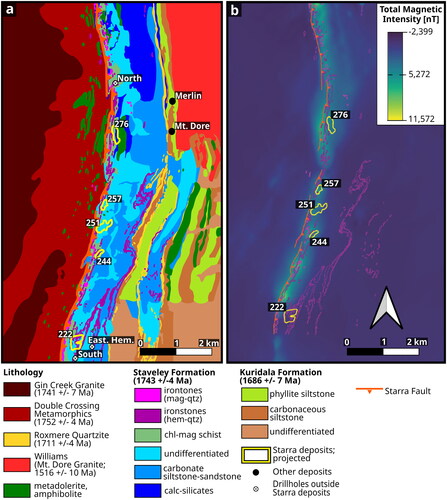
Two distinct ironstone zones occur close to the Starra system. Along the Selwyn shear zone, east of the deposits, barren hematite-dominated ironstones formed, whereas magnetite–hematite ironstones formed along the Starra shear zone and are associated with the Starra Au–Cu mineralisation ().
No intrusive phases occurring at depth beneath Starra were reported by previous workers, who focused on Starra 276 in the north and Starra 244, 251, and 257 in the middle of the Starra Line (). However, mafic intrusions have been intersected at depth below the Starra 222 ore body in recent drilling (), as well as in holes south of Starra 222, from the Eastern Hematite, and from one drill hole ∼6 km north of Starra 276. No mafic intrusions are present in drill holes from Starra 244, whereas at Starra 276, mafic and intermediate intrusions were recognised in the hanging wall of the ore zone (Duncan et al., Citation2014; supplemental data, Appendix 1). The ore lenses at Starra have a variable strike and dip at surface, but if extrapolated downwards, they appear to converge on roughly the same point at ∼5 km depth.
Figure 3. Cross-section through Starra 222 based on drill holes STD1119, STQ 1042 and to the south STQ 1091. Drill hole STQ1119 and STQ1042 both intersect the main ore body. The ore body crops out at the surface and reaches down to ∼470 m in drill hole STQ1042. At ∼650 m depth, magnetite ironstones, with minor chalcopyrite mineralisation, are intersected. Sills of intermediate to mafic composition occur from 700 m onwards and become progressively more mafic and finer-grained with depth.
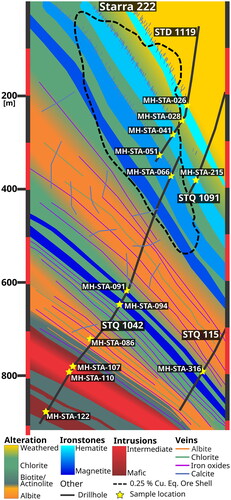
Lithological units
Metasedimentary rocks
Unaltered Staveley Formation in the Starra area comprises bedded metasiltstones of <1 mm grainsize interspersed with rare ∼1 mm-sized quartz and pyrite layers (). The host rock is locally crosscut by <1 mm-wide biotite veins forming extensive alteration halos highlighting the reactive nature of the metasedimentary protolith in the Starra area.
Figure 4. Main lithological units from the Starra Line. (a) Unaltered metasedimentary rocks of the Staveley Formation, consisting of layered quartz and biotite (MH_STA_086, STQ1042, 617.2 m). (b) Coarse-grained intrusion I with albite, pyrite, and anhydrite overprinting the original texture (MH_STA_110, STQ1042, 794.8 m). (c) Coarse-grained intrusion I crosscut by calcite–albite–pyrite–magnetite–epidote vein (MH_STA_107, STQ1042, 782.9 m). (d) Fine-grained mafic intrusion II lacking visible alteration (MH_STA_122, STQ1042, 906.3 m). (e) Magnetite–albite–quartz–chlorite schist from the Starra footwall (MH_STA_274, STQ1099W1, 216.85 m). (f) Mineralised ironstone from Starra 222 with magnetite–quartz–hematite–chalcopyrite (MH_STA_316, STQ115, 733.9 m). (g) Brecciated meta-arenite from the Starra 276 hanging wall with calcic matrix (MH_STA_194, STQ1070, 253.5 m). Mineral abbreviations: Ab, albite; Act, actinolite; Cal, calcite; Ccp, chalcopyrite; Ep, epidote; Mag, magnetite; Py, pyrite.
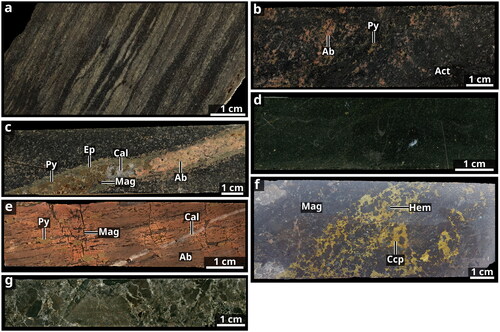
Intrusive units
Two distinct intrusive mafic–intermediate units, labelled intrusion I and intrusion II, occur in the footwall to the Starra 222 ore body. Between 650 and 800 m below surface, a coarse- to medium-grained intermediate intrusion (intrusion I) has been intersected by drilling at least three times. The major mineral phases of intrusion I are albite and actinolite. Accessory phases include magnetite, titanite, kaersutite [NaCa2Mg4Ti(Si6Al2O23)(OH)2], ilmenite, rutile, apatite and chlorite. The grainsize ranges between 5 and 8 mm for albite and actinolite, ∼1 mm for titanite and <1 mm for accessory phases (). The unit is crosscut by albite–calcite veins, with pyrite and magnetite, following an earlier epidote vein (). Intrusions with comparable compositions and textures have also been intersected at similar depths ∼6 km north of Starra 276 and ∼2 km south of Starra 222, although it is unclear whether these belong to the same unit.
A second, fine-grained mafic unit (intrusion II) is intersected >900 m below the surface at Starra 222 (). The main mineral phases of intrusion II are oligoclase, kaersutite, magnetite and pyrite. The average grainsize of the first three main phases is ∼1 mm, whereas pyrite is between 3 and 5 mm. Accessory mineral phases include titanite, ilmenite, apatite, quartz and zircon, with grainsizes of <0.1 mm. Magnetite contains inclusions of oligoclase, kaersutite and quartz. Both intrusions appear undeformed and massive, with no discernible foliation.
Footwall schist
The predominant lithology in the footwall to the Starra deposits is a chloritised quartz–albite–magnetite–biotite schist (). Less abundant mineral phases in this unit include titanite, rutile, chalcopyrite and pyrite. Although the main Cu–Au orebodies are hosted by the ironstones, the footwall schist can locally host economic mineralisation (Rotherham et al., Citation1998). Importantly, quartz, albite and biotite are slightly elongated, whereas chlorite, magnetite, pyrite and chalcopyrite show no evidence of deformation, such as pressure shadows or foliation wrapping around them. The strong magnetic anomaly along the Starra shear () is related to the abundance of magnetite occurring in this footwall unit.
Ironstones
The ironstones are present with a variable composition as steeply E-dipping lenses along the Starra shear. Mineral phases recorded within the ironstones include hematite, magnetite, quartz, calcite, chlorite, albite, barite, chalcopyrite, bornite and chalcocite. Two distinct types of hematite occur in the ironstones: a rounded, blebby hematite (Hem-I; ), containing relict inclusions of magnetite; and a euhedral, coarse-grained specular hematite (Hem-II; ), which is spatially associated with mineralisation. The relict magnetite in Hem-I suggests a transformation of magnetite to hematite in the ironstones, which occurred during subsequent alteration stages (e.g. Davidson, Citation1989; Rotherham, Citation1997). This transformation commonly occurred along the Starra and Selwyn shears, in both barren and mineralised ironstones.
In general, with decreasing depth, hematite becomes more dominant in the ironstones () and main-stage Cu mineralisation coincides spatially with the appearance of specular hematite ( and ). The formation of the ironstones is related to either metasomatic processes (Adshead-Bell, Citation1998; Rotherham et al., Citation1998) or syngenetic hydrothermal exhalation (Davidson, Citation1989). Oliver et al. (Citation2008) reported chalcopyrite bands in the ironstones that follow bedding planes and were folded by D2 folds during peak metamorphism. This suggests that some sulfides and ironstones pre-date peak metamorphism (Davidson, Citation1989) and Na–Ca alteration at Starra (Duncan et al., Citation2011, Citation2014). However, most of the Cu-sulfide mineralisation crosscuts foliation in the mineralised ironstones and overprints magnetite. Occurrences of elongated iron oxides aligned with the foliation along the Starra shear are observed in some places (). This might represent a post-deformational Cu–Au event (Adshead-Bell, Citation1998) or remobilising and concentration of earlier-formed Cu–Au mineralisation (Oliver et al., Citation2004).
Figure 5. Alteration assemblages affecting the main lithologies at the Starra deposits. The thickness of the bars indicates the relative abundance of each phase. Mineral abbreviations: Ccp, chalcopyrite; K-Fsp, K-feldspar; Wit, Wittichenite. (1)Age data for Na–Ca and Main Cu–Au stage after Duncan et al. (Citation2011).
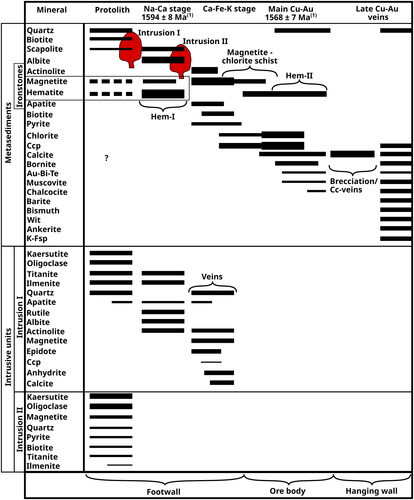
Although hematite predominates in the ironstones near the surface at Starra 222, magnetite becomes more abundant in the ironstone horizon with depth (). Drill hole STQ1042 (, below the Starra 222 orebody) intersected a sequence of magnetite-dominated ironstones from 650 to 700 m that host chalcopyrite mineralisation, but intriguingly, no Au phases are present. Magnetite is generally more common throughout the ironstone stratigraphy further north.
Figure 6. Representative drill core samples showing alteration and paragenetic relationships at the Starra Line. (a) Magnetite and biotite formed during K–Fe alterations overprinting albite–quartz assemblage associated with Na–Ca alteration. Chloritisation of biotite coincides with pyrite and chalcopyrite mineralisation. Calcite vein carrying chalcopyrite crosscuts Na–Ca and K–Fe alteration assemblages (MH_STA_091, STQ1042, 635.9 m). (b) Mineralised ironstone from Starra 222. Specular hematite is intergrown with chalcopyrite, while chloritisation of the wall rock replaces previous ironstone texture (MH_STA_041, STQ1119, 280.2 m). (c) Hematite-dominated ironstone from Starra 244 ore zone with disseminated calcite and bornite (MH_STA_175, STQ97-746, 337.5 m). (d) Barite–carbonate vein from the Starra 222 hanging wall carrying chalcocite/bornite, minor chalcopyrite and native bismuth. The wall rock consists of muscovite and K-feldspar (MH_STA_028, STD1119, 232.2 m). (e) Rounded hematite–quartz ironstone crosscut by barite veins containing minor amounts of native gold from the hanging wall to the Starra 222 main ore body (MH_STA_026, STD1119, 215.2 m). Mineral abbreviations: Ab, albite; Ank, ankerite; Bn, bornite; Brt, barite; Bt, biotite; Cal, calcite: Ccp, chalcopyrite; Cct, chalcocite; Chl, chlorite; Hem, hematite; Mag, magnetite; Py, pyrite; Qz, quartz.
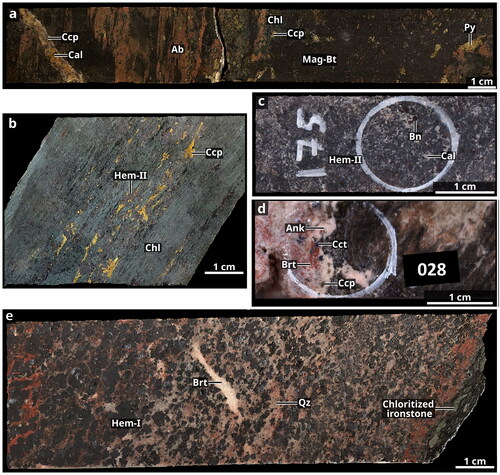
Hanging wall
In the hanging wall to both mineralised and barren ironstones, brecciated metasiltstones and meta-arenites occur (). The matrix of the breccias is calcic to silicic, with calcite, ankerite and quartz as main phases. Clasts consisting of quartz, minor biotite and chlorite are also present. The breccia facies alternates with metasiltstones that are crosscut by small calcite veins, locally referred to as calcite crackles. The transition between both facies is gradual.
Methods
A total of 322 samples were taken from 11 drill holes provided by Chinova Resources. Intervals ranging from 15 to 40 cm in length were collected form quartered or halved drill core. In addition, a total of 88 samples of 1 m intervals from six RC and diamond drill holes between Starra 222 and Starra 244 were collected. Five of these holes intersect three of the Starra deposits (two through Starra 222, one through Starra 244 and two through Starra 276), one was drilled south of Starra 222 along the Starra Line, one intersected the Eastern Hematite, and one was drilled north of Starra 276 (). Sampling focused on collecting a representative sample set across the different deposits to capture the variable mineralogy of the different lithologies. Rock plugs with 1-inch diameters were drilled out of halved or quartered drill core, mounted in epoxy resin and polished using diamond paste at the University of Tasmania’s lapidary facilities. Whole-mount automated scanning electron microscopy using Mineral Liberation Analysis software was undertaken at the Central Science Laboratory (CSL), University of Tasmania, using an FEI MLA650 scanning electron microscope (SEM). Detailed backscattered electron (BSE) imaging was done using a Hitachi SU-70 field emission SEM (FESEM) at the CSL, which is equipped with a Hitachi photo-diode BSE detector and Oxford AZTec energy-dispersive X-ray spectrometry system with an XMax 80 silicon drift detector.
Table 1. Samples shown in this study, and their geological context.
Samples for whole-rock geochemistry were analysed at the ALS Geochemistry laboratories in Townsville and Brisbane, Australia. Specific ALS analytical packages employed were ME-MS61 (48 element four-acid ICPMS), ME-OG62 (Ore Grade Elements—Four-Acid, Ag, As, Cd, Co, Cr, Cu, Fe, Mg, Mn, Mo, Ni, Pb, S, Zn), Cu-OG62 (Ore Grade Cu—Four-Acid) and Au-AA23 (Au 30 g FA-AA finish). Samples were prepared by standard crushing procedures followed by pulverising a 1000 g split to 85% passing less than 75 µm. Either a tungsten carbide or a standard steel mill was used, and so data for W, C and Co are suspect. Trace-element concentrations except Au were analysed by four-acid digest (HNO3, HF, HClO4 and HCl) with an inductively coupled plasma-atomic emission spectroscopy (ICP-AES) finish for ME-OG61 and ME-OG62 and an ICPMS finish for ME-MS61. Gold concentrations were analysed via fire assay with an AAS finish. Accuracy for all elements was determined by the reproducibility of standards and duplicates following ALS Minerals Brisbane in-house quality control protocols.
Trace-element analysis of calcite-, hematite- and sulfide-bearing samples was acquired during three different sessions at the CODES Analytical Laboratories using a RESOlution laser ablation system equipped with Coherent CompexPro 110 ArF excimer laser operating at a wavelength of 193 nm and pulse width of 20 ns coupled to an Agilent 7700 ICPMS. Both systems were equipped with a Lauren Technic large-format S-155 sample cell. The ablation was conducted in a He atmosphere flowing through a sample cell at a 350 mL/min flow, and a ∼1 L/min Ar gas was added before the aerosol was carried to the plasma torch. Data reduction was carried out using LADR software (Danyushevsky & Norris, Citation2018). Fe was used as internal standard element, and quantification was performed by normalising compositions to 100% oxide total. ICPMS was tuned to maximise sensitivity and maintaining a U/Th of ≈1.05 while ablating a line scan of the NIST612 glass at 40 µm beam at 10 Hz. Production of molecular oxide species (i.e. 232Th16O/232Th) was maintained at levels below 0.2%, while double-charged ion species production (i.e. 44Ca++/44Ca+) was kept under 0.1%. Analytical methods contain 49 isotopes for hematite and sulfide analysis. The full list of elements and their associated isotopes is as follows: 23Na, 24 Mg, 27Al, 29Si, 31P, 34S, 39K, 43Ca, 49Ti, 51V, 53Cr, 55Mn, 57Fe, 59Co, 60Ni, 65Cu, 66Zn, 71Ga, 75 As, 77Se, 85Rb, 88Sr, 89Y, 90Zr, 93Nb, 95Mo, 107Ag, 109Ag, 111Cd, 118Sn, 121Sb, 125Te, 137Ba, 140Ce, 157Gd, 178Hf, 181Ta, 182W, 185Re, 195Pt, 197Au, 202Hg, 205Tl, 206Pb, 207Pb, 208Pb, 209 Bi, 232Th and 238U. For calcite analysis the analytical method contained 47 isotopes: 7Li, 23Na, 24 Mg, 27Al, 29Si, 31P, 35Cl, 39K, 43Ca, 47Ti, 51V, 53Cr, 55Mn, 57Fe, 59Co, 60Ni, 63Cu, 66Zn, 75 As, 85Rb, 88Sr, 89Y, 90Zr, 93Nb, 107Ag, 111Cd, 118Sn, 137Ba, 139La 140Ce, 141Pr, 146Nd, 147Sm, 153Eu, 157Gd, 163Dy, 166Er, 172Yb, 175Lu, 178Hf, 181Ta, 197Au, 206Pb, 207Pb, 208Pb, 232Th and 238U.
Paragenetic sequence
Na–Ca alteration (stage I)
Sodic–calcic alteration is widespread around the Starra deposits, overprinting metasedimentary rocks of the Staveley Formation at most localities. Early Na–Ca alteration consists of albite–quartz–actinolite–scapolite–titanite assemblages when overprinting metasedimentary rocks. Previous authors argued that Na–Ca alteration occurred syn-D4 (Adshead-Bell, Citation1998; Rotherham et al., Citation1998), whereas Duncan et al. (Citation2011) argued for a syn-D2 event based on U–Pb dating of titanite. Albite, actinolite and rutile in intrusion I likely formed during the Na–Ca stage via alteration of the primary igneous minerals (). Albite replaced oligoclase, whereas actinolite contains inclusions of kaersutite (). Titanite with ilmenite inclusions further suggests a hydrothermal overprint of intrusion I during Na–Ca alteration (). Inclusions of ilmenite and rutile in titanite () resemble the texture and inclusion mineralogy of titanite used for U–Pb geochronology by Duncan et al. (Citation2011).
Figure 7. Reflected light photograph (a, c, e) and backscattered electron images (b, d, f) of intrusive units from the Starra 222 footwall. (a, b) Coarse-grained intrusion I showing rutile and ilmenite inclusions in titanite and albite overprinting actinolite (MH_STA_107a). (c) Anhydrite and pyrite reflect hydrothermal overprint of coarse-grained intrusion I (MH_STA_110). (d) Inclusions of Au–Te–Bi in pyrite from intrusion II resembles gold mineralisation in the main ore zone (MH_STA_110). (e, f) Fine-grained intrusion II consists of actinolite, oligoclase and magnetite. Ilmenite inclusion occur in titanite (MH_STA_122c). (g) Automated mineral identification and characterisation system (AMICS) map of intrusion I showing a similar region as in (c). (h) AMICS map of intrusion II highlighting mineral phases shown in (e). Mineral abbreviations: Ab, albite; Act, actinolite; Anh, anhydrite; Ap, apatite; Bt, biotite; Cal, calcite; Ccp, chalcopyrite; Chl, chlorite; Ep, epidote; Ilm, ilmenite; Krs, kaersutite; Mag, magnetite; Oli, oligoclase; Py, pyrite; Qz, quartz; Rt, rutile; Ttn, titanite.
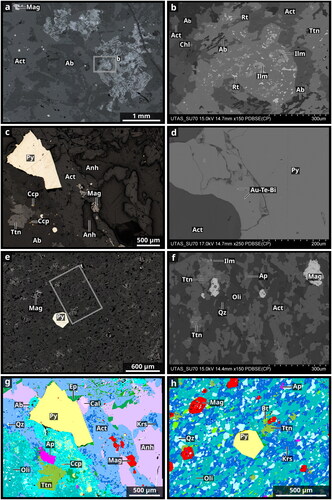
Ca–Fe–K alteration (stage II)
The development of magnetite and actinolite in mafic rocks such as intrusion I () is typical for Ca–Fe alteration stages in IOCG systems around the world (Corriveau, Montreuil, Potter, et al., Citation2022; Hitzman et al., Citation1992, Williams et al., Citation2005; Skirrow, Citation2022a). The Ca–Fe stage at Starra 222 is restricted to intrusions I and II (), whereas the metasedimentary rock units show an alteration assemblage typical for the K–Fe stage. Anhydrite is also present in intrusion I and is intergrown with minerals belonging to the Ca–Fe–K stage (). However, anhydrite is not typically associated with Ca–Fe or K–Fe alteration stages during IOCG formation (Corriveau, Montreuil, Potter, et al., Citation2022; Hitzman et al., Citation1992, Williams et al., Citation2005). In intrusion II, pyrite and minor K-feldspar suggest a progression towards the K–Fe alteration stage, with pyrite hosting Au–Te–Bi-rich nano-inclusions (). Oligoclase, which is the dominant feldspar in intrusion II, commonly forms at the transition from Na–Ca to high-temperature Ca–Fe alteration in other IOCG systems globally (Corriveau, Montreuil, Blein, et al., Citation2022).
Magnetite and biotite are the dominant mineral phases throughout the early high-temperature K–Fe alteration stage (), which overprinted Na–Ca alteration in footwall schists of the Starra deposits. Associated sulfides that formed during K–Fe alteration are pyrite and chalcopyrite (). Massive magnetite–biotite veins crosscut Na–Ca alteration ( and ), suggesting a metasomatic origin of the magnetite ironstones at Starra during stage II, which post-dated the peak of regional metamorphism (Rotherham, Citation1997). However, as shown by previous authors (e.g. Duncan et al., Citation2014), more than one phase of iron metasomatism occurred at Starra, with the earliest phases occurring pre-D2 (e.g. F2 folds in magnetite–hematite ironstones; Davidson & Large, Citation1994).
Rare but distinctive textures of iron oxides in the magnetite ironstones, such as mushketovite and zoned magnetite, support a model of magnetite overprinting earlier hematite-rich ironstones by reduced, high-temperature K–Fe alteration. Furthermore, relict hematite associated with scheelite inclusions in an inclusion-rich magnetite core is overgrown by an inclusion-poor magnetite rim, which coincided with chalcopyrite formation (). Mushketovite is also host to nano-inclusions of scheelite in our samples (), a texture that has been reported in other IOCG and Fe skarn systems such as Mina Justa, Peru (Hu et al., Citation2020; Rodriguez-Mustafa et al., Citation2022), and the Island Dam IOCG prospect, Gawler Craton, South Australia (Keyser et al., Citation2022).
Figure 8. Reflected light photograph (a) and backscattered electron (BSE) images (b–d) of magnetite-dominated ironstones below the Starra 222 main mineralisation. (a, b) Hematite partly replaced by magnetite in the ironstone leading to the formation of scheelite inclusions (MH_STA_091b, STQ1042, 635.9 m). (c, d) Mushketovite texture in the magnetite-dominated ironstones with scheelite inclusions (MH_STA_094, STQ1042, 660.25 m). Mineral abbreviations: Ccp, chalcopyrite; Hem, hematite; Mag, magnetite; Muk, mushketovite; Sch, scheelite.
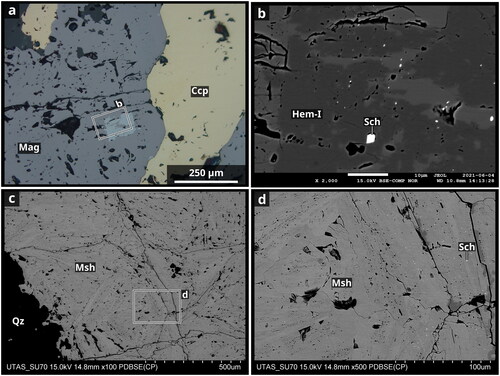
Main Cu–Au mineralisation stage (stage III)
Chalcopyrite, the main Cu mineral formed during stage III, is associated with Hem-II formation in both magnetite–hematite and hematite-dominated ironstones (). Typical ore mineral assemblages in the ironstones comprise chalcopyrite (variably replaced by bornite), native gold and Au–Bi-tellurides associated with bornite (). Pyrite pre-dates chalcopyrite and bornite formation and is crosscut by chalcopyrite overprinting Hem-I (). Stage III represents a lower-temperature evolution from stage II, which was chlorite and quartz stable, leading to pervasive chlorite alteration of the high-temperature K–Fe alteration assemblages (). Importantly, chlorite formation is closely associated with the transition of magnetite to Hem-II as the primary iron oxide phase in the ironstones, together with the main Cu–Au mineralisation. Bornite replaces Hem-II in the upper part of the ironstones, a texture that is commonly present in regimes of high fO2 (e.g. Torresi et al., Citation2012). Some mineralisation assemblages in the ironstones include calcite together with Hem-II and bornite ().
Figure 9. Reflected light photographs (a–c) and BSE Image (d) of mineralised ironstones from Starra 276 and 222. (a) Chalcopyrite and Hem-II form, while magnetite remains intact (MH_STA_215, STQ1091, 388.9 m). (b) Relict magnetite in porous, rounded Hem-I and specular Hem-II associated with chalcopyrite precipitation (MH_STA_066a, STQ1042, 364.2 m). (c, d) Chalcopyrite overprinting pyrite and granular, porous Hem-I. Precipitation of free gold coincides with chalcopyrite ± bornite formation. Both fill pyrite cracks (MH_STA_051, STD1119, 322.9 m). Mineral abbreviations: Ccp, chalcopyrite; Chl, chlorite; Hem, hematite; Mag, magnetite; Py, pyrite; Qz, quartz.
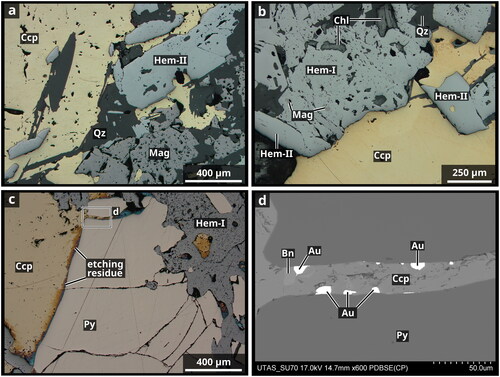
Figure 10. Reflected light photographs (a, c, e) and BSE images (b, d, f) showing Au–Cu mineralisation at Starra 222. (a, b) Bornite replacing chalcopyrite is strongly associated with Au and Au-tellurides (MH_STA_041). (c, d) Calcite veins from the hanging wall to the Starra 222 ore zone carrying chalcocite, bornite, native bismuth and wittichenite (Cu3BiS3, MH_STA_028). (e, f) Free gold from porous hematite ironstone. Sulfides are absent in that assemblage (MH_STA_026). Mineral abbreviations: Bn, bornite; Brt, barite; Cal, calcite; Cav, calaverite; Ccp, chalcopyrite; Cct, chalcocite; Hem, hematite; Mag, magnetite; Ms, muscovite; Py, pyrite; Qz, quartz; Syl, sylvanite; Wit, wittichenite.
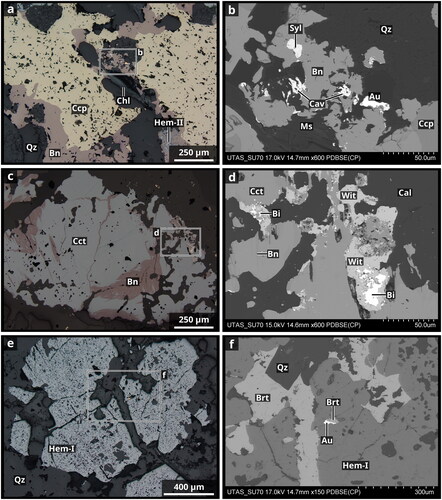
Late Ca–Ba-rich Cu–Au mineralisation (stage IV)
In the upper part of the Starra 222 ore body, barite–carbonate veins crosscut muscovite–K-feldspar altered host rocks (). The veins carry Au–Bi-tellurides, native bismuth, Cu–Bi-sulfides (wittichenite) and Cu sulfides (chalcocite, bornite, chalcopyrite) (). The presence of muscovite in the wall rock suggests a decrease in pH towards moderately acidic conditions during this late alteration stage (). Rotherham et al. (Citation1998) reported high-grade barite–calcite veins from Starra 244 (Au grades up to 55 g/t), which have been linked paragenetically to the main Cu mineralisation by some authors (e.g. Adshead-Bell, Citation1998). On the other hand, Duncan et al. (Citation2014) noted that the orientation of these veins is almost orthogonal to the near-vertical fabric associated with most chalcopyrite–magnetite veinlets, and consequently interpreted the high-grade barite–calcite veins as a distinct mineralisation event. The orientation of calcite–barite veins () is difficult to establish, but based on its stratigraphic position, alteration mineralogy and mineralisation style, we consider this vein set to be an example of the later (Cu–)Au stage IV ().
The uppermost ironstones at Starra 222 are largely barren and contain rounded hematite grains intergrown with abundant quartz, barite, and minor chlorite (). Sulfides are absent from these ironstones, but accessory native gold is associated with the barite and euhedral quartz formation (). Based on the extensive porosity present in this unit (some of which is filled by quartz) and the fact that this unit crosscuts chloritised ironstone, this lithology likely represents a late, low-temperature event that either remobilised existing Au or introduced new Au.
Results
Whole-rock geochemistry
Sampled rock types included barren ironstones, rocks exhibiting Na–Ca, Ca–Fe and K–Fe alteration assemblages, and mineralised ironstone sequences. Principal-component analysis (PCA) applied to the centred log ratio-transformed whole-rock data aimed to identify correlated elements and recognise the principal elements that define a Starra chemical fingerprint (). The eigenvalues of the first three principal components (PCs) are used for a k-nearest neighbour (k-NN) clustering algorithm, which defines four chemically distinct clusters (). For PCA and k-NN clustering, the tidymodels framework (Kuhn & Wickham, Citation2020), which is a collection of packages for the statistical programming language R (Ihaka & Gentleman, Citation1996), was used.
Figure 11. (a) Eigenvalue diagram showing the contributions to the first two principal components (PC) for selected elements in the whole-rock geochemistry dataset (see online data repository for complete dataset). (b) Four clusters defined by k-nearest neighbour classification separating low grade sample into clusters two and three, whereas mineralised samples are grouped into cluster one and four. (c) Principal component 2 distinguishing low Cu concentration from high Cu concentration. (d) Au vs Te diagram highlighting the close relationship between those elements.
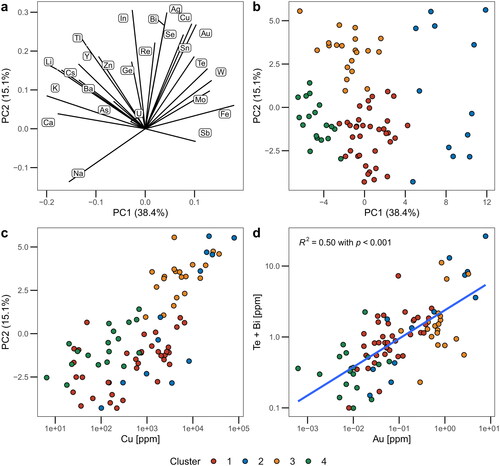
The first PC is mostly defined by Fe with positive eigenvalues and Na and Ca with negative eigenvalues, reflecting ironstone and albite alteration, respectively (). Gold and Cu are defined by both the first and second PCs and correlate positively with Se. Elevated concentrations of Bi, Ag, In and, to a lesser degree, Ba, are reflected by the second PC. Two chemically distinct clusters (cluster 1 and 4) are associated with mineralised samples (), which could reflect multiple mineralisation events at Starra. Cluster 1 is defined by the second PC and the first PC defines cluster 4. These PCs effectively discriminate between two mineralisation types: one associated with ironstones (cluster 4), and the second associated with elevated concentrations of Bi and, to a lesser degree, Ba (cluster 1). Importantly, the close association between Au, Cu and Te (±Bi) established via petrography is also indicated by the PCA of the whole-rock chemistry ().
LA-ICPMS analysis of mineral chemistry
One LA-ICPMS trace-element map comparing Hem-I and Hem-II from the mineralised ironstones () at Starra 222, and two LA-ICPMS trace-element maps of bornite and chalcopyrite assemblages (one from mineralised ironstones, ; and one from the calcite–barite vein, ) were generated. To discriminate chemically between the two hematite generations, PCA was applied to the centred log ratio-transformed data of the LA-ICPMS trace-element map. Concentrations of Co, Ni, Ga, W and, to a lesser degree, U are higher in Hem-I than in Hem-II, which is mostly defined along the first PC (). No correlation between Ca and W is observed, which indicates that neither generation of hematite contains micro-inclusions of scheelite, as recorded in the magnetite from the magnetite-dominated ironstones ().
Figure 12. (a) Reflected light photograph of hematite-dominated ironstone hosting chalcopyrite mineralisation from Starra 222. (b) Results from the principal-component analysis (PCA) highlights chemical differences between Hem-I and Hem-II. The black/white rectangle in (a) indicates the area imaged by LA-ICPMS shown in (c–k) (MH_STA_066, STQ1042, 399.4 m).
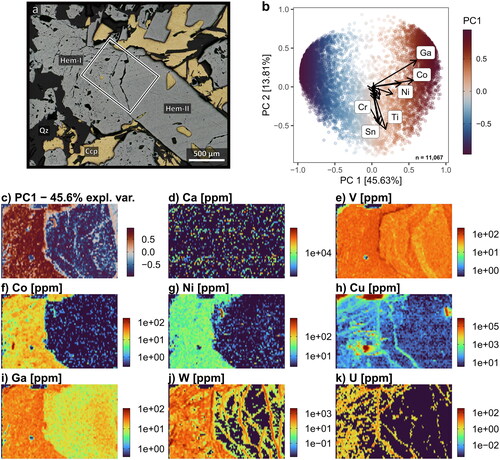
Figure 13. (a) Bornite replacing specular hematite. Both phases are overprinted by chalcopyrite. The black/white rectangle in (a) indicates the area imaged by LA-ICPMS shown in (b–g) (MH_STA_041, STD1119, 280.20 m). (h) Bornite with relict chalcopyrite carried on barite–carbonate vein above the Starra 222 ore zone. The black/white rectangle indicates the area imaged by LA-ICPMS shown in (i–n) (Sample MH_STA_028, STQ1119, 232.25 m).
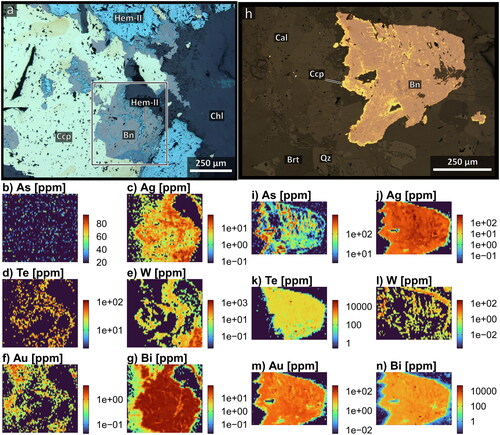
Bornite from the main Cu–Au stage Starra 222 ore zone is poor in trace elements compared with bornite associated with the late Cu–Au stage mineralisation. Bismuth concentrations are >10 ppm in main-stage bornite (), compared with <1 ppm in the main-stage chalcopyrite. Gold concentrations in the main-stage chalcopyrite are between 0.1 and 10 ppm, whereas in main-stage bornite, gold concentrations are <0.1 ppm (). Tungsten is only present in Hem-II, the latter of which is replaced by bornite. In contrast to main-stage bornite, bornite from the late-stage calcite–barite vein in the upper part of the Starra 222 ore zone has Au concentrations >10 ppm and Ag concentrations >100 ppm. Tellurium, Bi and Ag are all correlated positively with Au in bornite ().
Lead isotope characteristics of Starra 222 ore
The ratios of the uranogenic Pb isotopes (207Pb/206Pb) for Hem-I and Hem-II are close to the expected value for 1600 Ma (∼0.962), which represents the common Pb composition (Stacey & Kramers, Citation1975). For bornite and hematite from stage III, the Pb isotope data exhibit a univariate trend, with a 207Pb/206Pb ratio below 0.962. Stage IV Cu sulfides are comparable with stage III Cu sulfides at lower Pb concentrations, but the former display a bivariate trend with a major trend defined by a high 207Pb and low 206Pb, and a minor trend with low 207Pb and high 206Pb (). Most of the hematite and copper sulfides exhibit a low U/Pb ratio (<10; see online data repository).
Figure 14. Radiogenic lead isotopes 206Pb vs 207Pb from the hematite and bornite/chalcopyrite LA-ICPMS images shown in and . Hem-I and Hem-II have a radiogenic lead composition expected for 1600 Ma (Stacey & Kramers, Citation1975). Bornite and chalcopyrite from stage III and IV have a 206Pb/207Pb composition lower than the common lead trend at 1600 Ma, indicating remobilisation of 206Pb. Three 206Pb/207Pb trends are defined by stage III and IV sulfides.
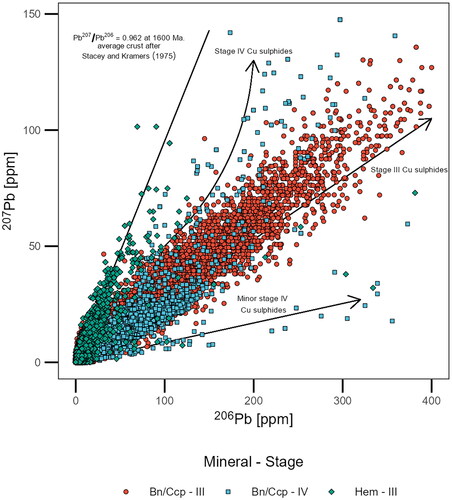
Calcite is present throughout stages II–IV, as either minor or major mineral phase (). A total of 341 calcite spots from 18 samples were obtained. Of the 341 analyses, 62 are below the detection limit for 206Pb and/or 207Pb. Radiogenic Pb compositions in calcite show two distinct trends (). Most stage II and IV calcites plot along the common lead composition ratio of 0.962, with some analyses following a radiogenic trend. Stage III calcite displays the strongest radiogenic trend (). Calcites from the Starra Line show a bivariate trend in the 206Pb vs 207Pb diagram, whereas calcites from the Eastern Hematite have a common lead composition (). The Cu sulfides and a portion of the calcite data that display low 207Pb/206Pb values necessitate an additional radiogenic Pb source (Davidson et al., Citation2007).
Discussion
Mafic to intermediate intrusions
The replacement of kaersutite by actinolite and oligoclase by albite in intrusion I () indicates hydrothermal alteration of primary magmatic mineral phases or high-temperature Ca–Fe assemblages during Na–Ca and Ca–Fe stages (the latter likely lower temperature), where actinolite is a common alteration product in IOCG systems (Corriveau, Montreuil, Blein, et al., Citation2022; Corriveau, Montreuil, Potter, et al., Citation2022; Hitzman et al., Citation1992; Skirrow, Citation2022a; Williams et al., Citation2005). Leaching of Cu and Au from mafic rocks during Na–Ca metasomatism in the Cloncurry district (Oliver et al., Citation2008) could have led to minor mineralisation syn-peak metamorphism (Davidson, Citation1989; Duncan et al., Citation2014), which coincides with Na–Ca alteration assemblages in the area (Duncan et al., Citation2011). Given the probable occurrence of metal leaching during Na–Ca alteration in intrusion I at Starra 222, igneous rocks within the IOCG ore-forming systems are a possible source for Cu and Au in the Starra deposit.
On the other hand, the pervasive Na–Ca alteration mineralogy that characterises intrusion I is not present in intrusion II (). Considering the extensive Na–Ca alteration in the Starra area (Davidson, Citation1989) and the broader Cloncurry district in general (Kendrick et al., Citation2008), the absence of this alteration phase indicates that intrusion II was emplaced post Na–Ca alteration. Furthermore, the formational temperature of the Cu–Au mineralisation at Starra 222 was higher than at the Starra deposits further north (Rotherham, Citation1997), suggesting that Starra 222 formed closer to a heat source. Magnetite, pyrite and minor biotite likely overprinted the intrusion suggesting intrusion II was exposed to K–Fe alteration (). Pyrite from these intrusions contains inclusions of Au–Te–Bi, which is consistent with the gold signature at Starra (). It is unclear exactly how the later mafic–intermediate intrusions relate to the mineralisation along the Starra Line, but their presence attests to a period of mafic magmatism occurring post peak metamorphism in the Selwyn–Mount Dore corridor. Stable isotopic data from sulfides, sulfates, calcite, and magnetite indicate that a significant magmatic fluid component was present at Starra during Cu–Au ore formation (Davidson, Citation1989; Rotherham et al., Citation1998). The magmatic signature of sulfides could have also been derived by leaching of sulfide from mafic rocks (Oliver et al., Citation2008).
Magnetite ironstone development—the significance of mushketovite
Mushketovite in the mineralised ironstones from the footwall of Starra 222 () demonstrates that earlier hematite was reduced to magnetite by a reduced and/or high-temperature fluid, with a composition below the hematite–magnetite buffer (). Similar mineralogy and textures have been reported at other IOCG systems globally: for example, at the Mina Justa IOCG deposit, Peru, the presence of mushketovite has been associated with multiple hydrothermal fluid pulses and fluctuating redox conditions (Hu et al., Citation2020; Rodriguez-Mustafa et al., Citation2022). These textures and mineralogical associations link the Starra deposits, which are commonly associated with the hematite group (Skirrow, Citation2022b), to other magnetite-group IOCG systems globally, in terms of their paragenetic evolution (Williams, Citation2022)
We propose that the magnetite ironstones reflect a previously unrecognised early stage of mineralisation at Starra. Significant fluctuations in (pyrite?) element concentrations at Starra are linked to substantial variations in sulfur concentrations and/or fO2 (Williams et al., Citation2001). The presence of abundant calcite and chlorite in these rocks (), as well as the evident reduction of hematite to magnetite, implies that the early mineralisation stage was characterised by a mildly reducing, near-neutral hydrothermal fluid. High-salinity concentrations, as observed in fluid inclusions (Williams et al., Citation2001), and potential high temperatures during early Ca–Fe alteration, as indicated by the predominance of oligoclase instead of albite (), promoted Cu transport in the reduced, near-neutral Cu–Au stage fluid (Hezarkhani et al., Citation1999; Liu & McPhail, Citation2005). A decrease in fO2 and a decrease in temperature by forming mushketovite and an increase in sulfur concentrations led to chalcopyrite mineralisation in the magnetite-dominated ironstones (). These conditions can potentially favour chalcopyrite precipitation while retaining Au in the fluid or concentrating Au at low grade in chalcopyrite () and making it available for remobilisation during subsequent fluid pulses.
Hematite + Cu–Au mineralisation
In the ironstone package, the martitisation of magnetite (Hem-I; ) occurred spatially independently from Cu mineralisation. The main stage of Cu–Au mineralisation at Starra is associated with coupled Cu-sulfide (mainly chalcopyrite) and specular hematite (Hem-II) precipitation (). The sequence of sulfide precipitation (pyrite → chalcopyrite → bornite → chalcocite; and ) indicates a progressive decrease in fS2, an increase in fO2 and/or an increase in the Cu:Fe ratio in the ore-bearing fluid. In hydrothermal environments, iron is commonly transported as a chloride complex, precipitating magnetite while forming HCl– (Ding & Seyfried, Citation1992; Heinrich & Seward, Citation1990). The resulting decrease in pH can form advanced argillic alteration zones in the upper part of IOCG deposits (Kreiner & Barton, Citation2017), whereas at deeper levels, biotite to chlorite and feldspar to sericite alteration buffers the pH conditions to near-neutral (Baker, Citation1998). Owing to the low stability of chlorite under a low pH (Brandt et al., Citation2003), the abundant chlorite alteration indicates that the acid produced during the magnetite precipitation was effectively buffered (Barton, Citation2014). Based on the abundance of chlorite and calcite as well as minor muscovite associated with the main mineralisation stage (), the overall pH of the fluid is suggested to be mildly acidic to neutral (cf. Corbett & Leach, Citation1998). The main Au mineralisation episode occurred at the same time, and both Au and Cu postdate pyrite formation (). These relationships indicate that the solubility of Au would have been significantly decreased by wall-rock sulfidation processes if gold were transported as a bisulfide complex. The reduced fluid that formed mushketovite reached the magnetite–hematite redox buffer during the main Cu–Au stage (), as indicated by the common coexistence of magnetite and hematite in the ore (). On the other hand, hematite-free magnetite–chalcopyrite mineralisation in the magnetite ironstones of Starra 222 demonstrates that oxidation of magnetite to hematite was not essential to Cu–Au mineralisation. These textures indicate that redox conditions during mineralisation straddled the magnetite–hematite buffer ().
Late-stage Cu–Au–Bi mineralisation
At Starra 222, Au–Bi–Te mineralisation is associated with bornite after chalcopyrite, and it also occurs in stage II pyrite hosted in intrusion II (), as well as stage III hematite ironstones (). Bornite and chalcopyrite are generally considered poor host minerals of Au compared with other sulfides, such as pyrite (Cook et al., Citation2011). Indeed, within the main Starra 222 ore zone, the Au concentrations of bornite and chalcopyrite are below 1 ppm (). In a study of hydrothermal and metamorphic bornite from 12 European skarn, epithermal and porphyry Cu–Au deposits, Cook et al. (Citation2011) found that the maximum concentration of Au in solid solution in bornite was 28 ppm, making it likely that Au exists as micro-inclusions of Au–Bi-tellurides in bornite.
Native Au in the hematite ironstones () suggests the presence of a second gold-bearing fluid at Starra. Muscovite in wall rock associated with stage IV indicates decreasing pH, but still within the stability field of calcite. Mineralisation during this stage requires an oxidised fluid as inferred from chalcocite and barite. However, the transport of Ba and formation of native Bi during stage IV is consistent with reduced fluids (Skirrow & Walshe, Citation2002).
At Starra, the relatively low temperature during the main mineralisation stage, compared with other IOCG deposits in the Cloncurry district (e.g. Ernest Henry, ∼450 °C, Mark et al., Citation2000; Osborne, >450 °C, Adshead et al., Citation1998; Eloise, ∼500 °C, Baker, Citation1998), might have promoted the remobilisation of Au. The highly radiogenic Pb composition of Cu sulfides at Starra indicates a secondary fluid remobilised radiogenic Pb and by extension Cu and Au (). Low 207Pb/206Pb ratios in Cu sulfides at Olympic Dam are associated with a later mineralisation event, remobilising some of the radiogenic Pb and likely Cu (Ehrig et al., Citation2021). Remobilisation by late fluids is further supported by the bivariate trends of radiogenic Pb in calcite associated with stage IV ().
Figure 15. Plots of 206Pb vs 207Pb from calcite. (a) Calcites from paragenetic stages II and IV have a mostly common Pb composition at 1600 Ma (Stacey & Kramers, Citation1975), whereas stage I, III calcites follow a radiogenic trend. (b) Calcite from the barren Eastern Hematite follow the common Pb trend, whereas calcites from the mineralised Starra line follow a radiogenic Pb and the common Pb trend.
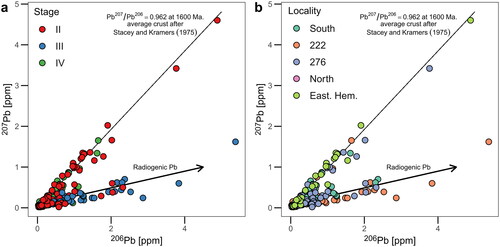
Ore deposits model for Starra
In other IOCG districts where hematite ironstones are associated with Au-rich IOCG deposits, such as those of the Tennant Creek Inlier, Northern Territory, previous workers have invoked the involvement of oxidised Na–Ca–Cl brines to explain their development (e.g. Large, Citation1975; Skirrow & Walshe, Citation2002; Zaw et al., Citation1994a, Citation1994b). At Starra, some of the hematite-rich ironstones might have formed via the interaction of saline brines with the local rock package, leaching Fe and K from wall rocks during albitisation (Williams, Citation1994). At Starra, the main phase of iron metasomatism occurred during the Na–Ca stage, which is permissive of the involvement of metamorphic-derived fluids during at least part of the ironstone formation (Duncan et al., Citation2011). Fluids in the Cloncurry area associated with Na–Ca metasomatism are of both magmatic and non-magmatic origin (Kendrick et al., Citation2008). At the nearby ironstone-hosted Osborne Cu–Au deposit, there is evidence of pre-1530 Ma mineralisation (Davidson, Citation1992; Gauthier et al., Citation2001; Oliver et al., Citation2008). Fluid inclusions with high 40Ar/36Ar and variable Br/Cl and I/Cl ratios indicate that mineralisation at Osborne occurred by mixing of metamorphic fluids (Fisher & Kendrick, Citation2008). At Starra, enriched δ18O values calculated for fluids in equilibrium with hematite assemblages indicate the presence of at least one magmatic fluid source (Rotherham et al., Citation1998; Williams et al., Citation2005) in addition to the proposed metamorphic fluid. The distinct trace-element chemistry of Hem-II (specular hematite) compared with Hem-I suggests the involvement of fluids with different chemistries, which supports those previous authors who maintained that mineralisation and hematite-dominated ironstone formation were distinct events at Starra (Davidson, Citation1989; Duncan et al., Citation2011; Oliver et al., Citation2004; Williams et al., Citation2001). Moreover, Ba concentrations in fluid inclusions associated with the mineralisation stage are significantly higher than in fluid inclusions from the ironstone stage (Williams et al., Citation2001). The transport of Ba is commonly associated with reduced (H2S predominant) and acidic fluids (Cooke et al., Citation2000), which implies the presence of such fluids during the early Cu–Au mineralisation stage, whereas the ironstones along the Starra shear formed from a more oxidised fluid, potentially carrying sulfate, as suggested by the presence of barite () and anhydrite (Davidson et al., Citation1989; Rotherham et al., Citation1998). Fluid inclusions from both ironstone and main mineralisation contain considerable concentrations of Cu (Williams et al., Citation2001), but owing to the oxidised nature of the ironstone stage fluid and the inferred lack of reduced sulfur (Williams et al., Citation2005), only minor chalcopyrite formed initially from this fluid. The presence of multiple fluids at Starra is further supported by the Pb isotope composition of Cu sulfides and calcite. At Oak Dam East, a breccia hosted IOCG deposit in the Gawler Craton, low 207Pb/206Pb ratios in chlorite were interpreted to reflect a later recrystallisation event (Davidson et al., Citation2007). Based on low radiogenic Pb composition in Cu sulfides from Olympic Dam, Ehrig et al. (Citation2021) concluded that uranium mineralisation occurred during at least two distinct stages. At Starra, the 207Pb/206Pb ratio of hematite broadly agrees with an origin at 1600 Ma, which likely reflects the formation of hematite ironstones. The strongly radiogenic Pb isotope composition of Cu sulfides suggests a younger mineralisation stage, during which at least U was mobile (). In addition, calcite from the barren Eastern Hematite has a similar common Pb isotope composition to that of the Starra Line hematite, which indicates a common fluid source. Low 207Pb/206Pb ratios in calcite from Starra and calcite formed during stage III indicate that recrystallisation and/or remobilisation of radiogenic Pb discriminates barren from mineralised hematite ironstone in the Starra area and potentially in the Cloncurry district ().
In contrast to the relative scarcity of Bi minerals in the Cloncurry district, such Bi-rich assemblages are ubiquitous in the Tennant Creek IOCG deposits, Northern Territory (Huston et al., Citation1993; Large, Citation1975; Skirrow & Walshe, Citation2002; Wedekind et al., Citation1989). Native Bi is reported from deposits that fall on the reduced to intermediate spectrum. At both Gecko K-44 and White Devil, native bismuth is associated with a late-stage carbonate assemblage, like that seen at Starra (Huston et al., Citation1993). At Starra, the presence of at least two distinct fluids (Duncan et al., Citation2011; Williams et al., Citation2001), abundant hematite-dominated ironstones and an atypical Au ± Bi-rich style of IOCG mineralisation suggest a similar process of formation to that proposed for the Tennant Creek ore deposits (). In this model, an oxidised, Na–Ca–Cl-rich brine is responsible for the main Fe-metasomatism and led to the hematite replacement of magnetite. Iron and potentially Cu might have been leached from wall rocks (Oliver et al., Citation2004) such as intrusion I. Multiple subsequent pulses of a mildly reduced, Cu- and Au-bearing fluid reacted with the ironstones, converting hematite back to magnetite, particularly at greater depths. In our revised Starra model, the hematite–magnetite ironstone stage fluids functioned as an oxidised, Cu-undersaturated chemical trap for an initially reduced ore-bearing fluid that reached hematite–magnetite stability during the main mineralisation stage (). The main Cu–Au stage formation at Starra is interpreted to have been caused by a combination of decreasing temperature, desulfidation and mixing with a Cu-undersaturated fluid associated with the ironstone stage. Gold-dominant mineralisation (with minor Bi and Cu), representing a later hydrothermal stage, was caused by an increase in fO2, as evidenced by barite formation and a lack of sulfides.
Figure 16. Diagrams of two-stage paragenetic model for the Starra Cu–Au deposits. (a) During the first stage Ironstone lenses form along the Starra shear from a sulfur poor fluid near magnetite–hematite stability. (b) Gold–Cu mineralisation during the second stage formed via mixing of a mildly reduced fluid with an oxidised fluid. Previously formed ironstones provided pathways for fluid ascent. At deeper levels, early Hem-I is transformed to magnetite, increasing the fO2 of the initially reduced fluid leading to Au mineralisation in the upper part.
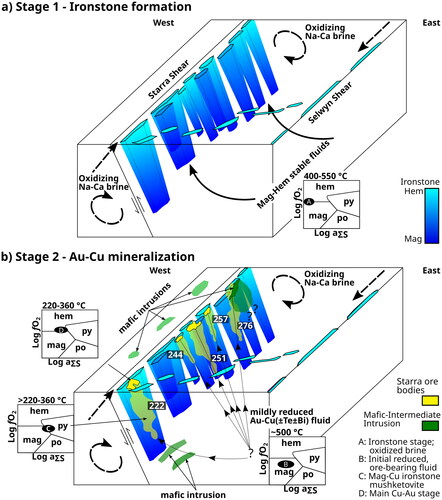
Conclusions
We propose a two-stage paragenetic model for Starra deposits. During the first stage, barren hematite-dominated ironstones formed in association with regional Na–Ca alteration. A downhole transition of alteration assemblages of chlorite + hematite + quartz ± muscovite into actinolite + magnetite + biotite ± pyrite suggests a decrease in fO2 and increase in temperature proximal to mafic sills below Starra 222. Mafic intrusions in the Starra footwall are pervasively altered by Na–Ca and Ca–Fe(–K) alteration. Those intrusions might have provided sulfur and metals via leaching to the metasomatic system. More mafic intrusions may well occur below current drilling depths at the deposits north of Starra 222. A better understanding of the role of these mafic intrusions in IOCG genesis at Starra could aid exploration efforts along the Starra system and elsewhere in the Cloncurry district.
The early ironstones served as oxidised chemical traps for the ore fluid during the second stage. The ore fluid was initially reduced (i.e. below the hematite buffer), based on textural evidence of magnetite recrystallisation and the occurrence of mushketovite together with biotite alteration and chalcopyrite–bornite(?) mineralisation in deep ironstones. This early magnetite-dominated Cu(–Au) assemblage links Starra to other magnetite-group IOCGs. The two-stage model is further supported by distinct radiogenic Pb isotope compositions observed in Hem-I (high 207Pb/206Pb) compared with Cu sulfides (low 207Pb/206Pb). The pH conditions during the main mineralisation stage were mildly acidic to near-neutral, inferred from the coexistence of chlorite, calcite and muscovite associated with Cu sulfides (bornite, chalcopyrite) and Au-tellurides. These conditions favoured Au transport as a bisulfide complex. An increase in fO2, decrease in temperature and minor decrease in pH, as shown by the formation of specular hematite and minor muscovite associated with the main mineralisation stage, were efficient mechanisms that drove mineralisation at Starra. As shown by Williams et al. (Citation2001), multiple fluids were present during Cu–Au ore formation at Starra. Mixing of an oxidised Na–Ca–Cl fluid and/or wall rock–fluid reaction between hematite ironstones with a reduced ore fluid could explain the formation of barite–carbonate veins carrying native Bi, wittichenite and Au-tellurides, as well as minor S-poor sulfides (chalcocite, bornite and chalcopyrite). Oxidised fluids might have refined gold during late-stage, low-temperature alteration, explaining the relative gold-rich nature of the Starra deposits compared with other IOCG prospects in the Cloncurry district.
Supplemental Material
Download PDF (309.1 KB)Supplemental Material
Download MS Excel (1.1 MB)Acknowledgements
We would like to thank Chinova Resources (Damian Jungmann and team) for assistance during fieldwork, logistical support and financial support for whole-rock analysis. Paul Olin at the CODES Analytical Laboratories is thanked for support during LA-ICPMS analysis, Karsten Goemann and Sandrin Feig for assistance during electron microscopy at the Central Science Laboratory, UTAS. We acknowledge fruitful discussions with Sebastien Meffre about the significance of Pb isotopes in IOCG deposits. Roger G. Skirrow is thanked for his thorough but positive and encouraging review, which greatly helped improve the manuscript.
Disclosure statement
The authors report there are no competing interests to declare.
Data availability
The authors confirm that the data supporting the findings of this study are available within the article and its supplementary materials. The geochemical data that support the findings of this study are openly available at xxx. Data for LA-ICPMS images are available from the corresponding author M.H. on request.
Additional information
Funding
References
- Adshead, N. D. (1995). Geology, alteration and geochemistry of the Osborne Cu–Au deposit, Cloncurry district, NW Queensland, Australia [Unpublished PhD thesis]. James Cook University of North Queensland.
- Adshead, N. D., Voulgaris, P., & Muscio, V. (1998). Osborne copper–gold deposit. In D. A. Berkman & D. H. McKenzie (Eds.), Geology of Australian and Papua New Guinean mineral deposits (Vol. 22, pp. 793–800). Australasian Institute of Mining and Metallurgy Monograph.
- Adshead-Bell, N. S. (1998). Evolution of the Starra and Selwyn high-strain zones, Eastern Fold Belt, Mount Isa Inlier; implications for Au–Cu mineralization. Economic Geology, 93(8), 1450–1462. https://doi.org/10.2113/gsecongeo.93.8.1450
- Baker, T. (1998). Alteration, mineralization, and fluid evolution at the Eloise Cu–Au deposit, Cloncurry district, northwest Queensland, Australia. Economic Geology, 93(8), 1213–1236. https://doi.org/10.2113/gsecongeo.93.8.1213
- Baker, T., Mustard, R., Fu, B., Williams, P. J., Dong, G., Fisher, L., Mark, G., & Ryan, C. G. (2008). Mixed messages in iron oxide–copper–gold systems of the Cloncurry district, Australia: Insights from PIXE analysis of halogens and copper in fluid inclusions. Mineralium Deposita, 43(6), 599–608. https://doi.org/10.1007/s00126-008-0198-y
- Barton, M. D. (2014). Iron oxide (–Cu–Au–REE–P–Ag–U–Co) systems. In H. D. Holland & K. K. Turekian (Eds.), Treatise on geochemistry (2nd ed., pp. 515–541). Elsevier Inc. https://doi.org/10.1016/b978-0-08-095975-7.01123-2
- Barton, M. D., & Johnson, D. A. (1996). Evaporitic-source model for igneous-related Fe oxide–(REE–Cu–Au–U) mineralization. Geology, 24(3), 259–262. https://doi.org/10.1130/0091-7613
- Barton, M. D., Johnson, D. A., & Porter, T. M. (2000). Alternative brine sources for Fe-oxide (–Cu–Au) systems: Implications for hydrothermal alteration and metals. In T. M. Porter (Ed.), Hydrothermal iron oxide copper–gold and related deposits: A global perspective (1st ed., pp. 43–60). PGC Publishing.
- Blake, D. H. (1992). The compressional Lake Mary Kathleen fold and thrust zone, Mount Isa Inlier. In A. J. Stewart & D. H. Blake (Eds.), Detailed studies of the Mount Isa Inlier (Vol. 243, pp. 181–190). Australian Geological Survey Organisation, Bulletin. https://pid.geoscience.gov.au/dataset/ga/36
- Blake, T. S., & Groves, D. I. (1987). Continental rifting and the Archean–Proterozoic transition. Geology, 15(3), 229–232.(1987) https://doi.org/10.1130/0091-7613
- Brandt, F., Bosbach, D., Krawczyk-Bärsch, E., Arnold, T., & Bernhard, G. (2003). Chlorite dissolution in the acid pH-range: A combined microscopic and macroscopic approach. Geochimica et Cosmochimica Acta, 67(8), 1451–1461. https://doi.org/10.1016/S0016-7037(02)01293-0
- Cannell, J., & Davidson, G. J. (1998). A carbonate-dominated copper–cobalt breccia-vein system at the Great Australia deposit, Mount Isa Eastern Succession. Economic Geology, 93(8), 1406–1421. https://doi.org/10.2113/gsecongeo.93.8.1406
- Chinova Resources, P. L. (2017). Current resources and historic production provided by Chinova Resources. Geological Survey. https://geoscience.data.qld.gov.au/en/dataset/ds000039/resource/513127e0-2f30-47d6-a978-b0b4adccd190
- Cook, N. J., Ciobanu, C. L., Danyushevsky, L. V., & Gilbert, S. (2011). Minor and trace elements in bornite and associated Cu–(Fe)-sulfides: A LA-ICP-MS study of bornite mineral chemistry. Geochimica et Cosmochimica Acta, 75(21), 6473–6496. https://doi.org/10.1016/j.gca.2011.08.021
- Cooke, D. R., Bull, S. W., Large, R. R., & McGoldrick, P. J. (2000). The importance of oxidized brines for the formation of Australian Proterozoic stratiform sediment-hosted Pb–Zn (Sedex) deposits. Economic Geology, 95(1), 1–18. https://doi.org/10.2113/gsecongeo.95.1.1
- Corbett, G. J., & Leach, T. M. (1998). Southwest Pacific Rim gold–copper systems: Structure, alteration, and mineralization (Vol. 6, p. 318). Society of Economic Geologists, Special Publication. https://doi.org/10.5382/SP.06
- Corriveau, L., Montreuil, J-F., Blein, O., Ehrig, K., Potter, E. G., Fabris, A., & Clark, J. (2022). Mineral systems with IOCG and affiliated deposits: Part 2—geochemical footprints. In L. Corriveau, E. G. Potter, & A. H. Mumin (Eds.), Mineral systems with iron oxide–copper–gold (IOCG) and affiliated deposits (pp. 159–204). Geological Association of Canada. Special Paper 52.
- Corriveau, L., Montreuil, J-F., Potter, E. G., Ehrig, K., Clark, J., Mumin, A. H., & Williams, P. J. (2022). Mineral systems with IOCG and affiliated deposits: Part 1—metasomatic footprints of alteration facies. In L. Corriveau, E. G. Potter, & A. H. Mumin (Eds.), Mineral systems with iron oxide–copper–gold (IOCG) and affiliated deposits (pp. 113–158). Geological Association of Canada. Special Paper 52.
- Crosswell, D. (2014). Open Data Portal—South East Isa. Geological Survey of Queensland. https://geoscience.data.qld.gov.au/magnetotelluric/mt099992
- Danyushevsky, L. V., & Norris, A. (2018). Software and protocols for improved accuracy of LA ICP-MS analysis via quantification of matrix effects. Goldschmidt Abstracts, 513.
- Davidson, G. J. (1989). Starra and trough tank: Iron-formation-hosted gold–copper deposits of North-West Queensland, Australia [Unpublished PhD thesis]. University of Tasmania.
- Davidson, G. J. (1992). Hydrothermal geochemistry and ore genesis of sea-floor volcanogenic copper-bearing oxide ores. Economic Geology, 87(3), 889–912. https://doi.org/10.2113/gsecongeo.87.3.889
- Davidson, G. J., & Large, R. (1994). Gold metallogeny and the copper–gold association of the Australian Proterozoic. Mineralium Deposita, 29(3), 208–223. https://doi.org/10.1007/BF00206864
- Davidson, G. J., Large, R. R., Kary, G. L., & Osborne, R. (1989). The deformed Iron-formation-hosted Starra and Trough Tank Au–Cu mineralization: A new association from the Proterozoic Eastern Succession of Mount Isa, Australia. In R. R. Keays, W. R. H. Ramsay, & D. I. Groves (Eds.), The geology of gold deposits: The Perspective in 1988 (pp. 135–150). Society of Economic Geologists. https://doi.org/10.5382/Mono.06.10
- Davidson, G. J., Paterson, H., Meffre, S., & Berry, R. F. (2007). Characteristics and Origin of the Oak Dam East Breccia-Hosted, iron oxide Cu–U–(Au) deposit: Olympic Dam Region, Gawler Craton, South Australia. Economic Geology, 102(8), 1471–1498. https://doi.org/10.2113/gsecongeo.102.8.1471
- Day, R. W., Whitaker, W. G., Murray, C. G., Wilson, I. H., & Grimes, K. G. (1983). Queensland Geology: A companion volume to the 1: 2,500,000 scale geological map (1975) (p. 194). Queensland Geological Survey Publications.
- Ding, K., & Seyfried, W., Jr (1992). Determination of Fe–Cl complexing in the low pressure supercritical region (NaCl fluid): Iron solubility constraints on pH of subseafloor hydrothermal fluids. Geochimica et Cosmochimica Acta, 56(10), 3681–3692. https://doi.org/10.1016/0016-7037(92)90161-B
- Donchak, P. J. T., Bultitude, R. J., & Blake, D. H. (1981). Definitions of newly named and revised Precambrian stratigraphic and intrusive rock units in the Duchess and Urandangi 1:250 000 sheet areas, Mount Isa Inlier, northwestern Queensland. Queensland Geological Survey, Publication 233.
- Duncan, R. J., Hitzman, M. W., Nelson, E. P., & Togtokhbayar, O. (2014). Structural and lithological controls on iron oxide copper–gold deposits of the southern Selwyn-Mount Dore corridor, Eastern fold belt, Queensland, Australia. Economic Geology, 109(2), 419–456. https://doi.org/10.2113/econgeo.109.2.419
- Duncan, R. J., Stein, H. J., Evans, K. A., Hitzman, M. W., Nelson, E. P., & Kirwin, D. J. (2011). A new geochronological framework for mineralization and alteration in the Selwyn-Mount Dore corridor, Eastern fold belt, Mount Isa Inlier, Australia: Genetic implications for iron oxide copper–gold deposits. Economic Geology, 106(2), 169–192. https://doi.org/10.2113/econgeo.106.2.169
- Ehrig, K., Kamenetsky, V. S., McPhie, J., Macmillan, E., Thompson, J., Kamenetsky, M., & Maas, R. (2021). Staged formation of the supergiant Olympic Dam uranium deposit, Australia. Geology, 49(11), 1312–1316. https://doi.org/10.1130/G48930.1
- Escolme, A., Cooke, D. R., Hunt, J., Berry, R. F., Maas, R., & Creaser, R. A. (2020). The Productora Cu–Au–Mo deposit, Chile: A Mesozoic magmatic-hydrothermal breccia complex with both porphyry and iron oxide Cu–Au affinities. Economic Geology, 115(3), 543–580. https://doi.org/10.5382/econgeo.4718
- Fisher, L., & Kendrick, M. A. (2008). Metamorphic fluid origins in the Osborne Fe oxide–Cu–Au deposit, Australia: Evidence from noble gases and halogens. Mineralium Deposita, 43(5), 483–497. https://doi.org/10.1007/s00126-008-0178-2
- Foster, A., Williams, P. J., & Ryan, C. (2007). Distribution of gold in hypogene ore at the Ernest Henry iron oxide copper–gold deposit, Cloncurry district, NW Queensland. Exploration and Mining Geology, 16(3-4), 125–143. https://doi.org/10.2113/gsemg.16.3-4.125
- Foster, D. R., & Austin, J. R. (2008). The 1800–1610 Ma stratigraphic and magmatic history of the Eastern Succession, Mount Isa Inlier, and correlations with adjacent Paleoproterozoic terranes. Precambrian Research, 163(1-2), 7–30. https://doi.org/10.1016/j.precamres.2007.08.010
- Gauthier, L., Hall, G., Stein, H., & Schaltegger, U. (2001). The Osborne deposit, Cloncurry district: A 1595 Ma Cu–Au skarn deposit. Contributions of the Economic Geology Research Unit. James Cook University, 59, 58–59.
- Gibson, G., Meixner, A., Withnall, I., Korsch, R., Hutton, L., Jones, L., Holzschuh, J., Costelloe, R., Henson, P., & Saygin, E. (2016). Basin architecture and evolution in the Mount Isa mineral province, northern Australia: Constraints from deep seismic reflection profiling and implications for ore genesis. Ore Geology Reviews, 76, 414–441. https://doi.org/10.1016/j.oregeorev.2015.07.013
- Giles, D., & Nutman, A. P. (2002). SHRIMP U–Pb monazite dating of 1600–1580 Ma amphibolite facies metamorphism in the southeastern Mt Isa Block, Australia. Australian Journal of Earth Sciences, 49(3), 455–465. https://doi.org/10.1046/j.1440-0952.2002.00931.x
- Groves, D. I., Bierlein, F. P., Meinert, L. D., & Hitzman, M. W. (2010). Iron oxide copper–gold (IOCG) deposits through Earth history: Implications for origin, lithospheric setting, and distinction from other epigenetic iron oxide deposits. Economic Geology, 105(3), 641–654. https://doi.org/10.2113/gsecongeo.105.3.641
- Heinrich, C. A., & Seward, T. M. (1990). A spectrophotometric study of aqueous iron (II) chloride complexing from 25 to 200 °C. Geochimica et Cosmochimica Acta, 54(8), 2207–2221. https://doi.org/10.1016/0016-7037(90)90046-N
- Hezarkhani, A., Williams-Jones, A., & Gammons, C. (1999). Factors controlling copper solubility and chalcopyrite deposition in the Sungun porphyry copper deposit, Iran. Mineralium Deposita, 34(8), 770–783. https://doi.org/10.1007/s001260050237
- Hitzman, M. W., Oreskes, N., & Einaudi, M. T. (1992). Geological characteristics and tectonic setting of Proterozoic iron oxide (Cu–U–Au–REE) deposits. Precambrian Research, 58(1-4), 241–287. https://doi.org/10.1016/0301-9268(92)90121-4
- Hu, X., Chen, H., Beaudoin, G., & Zhang, Y. (2020). Textural and compositional evolution of iron oxides at Mina Justa (Peru): Implications for mushketovite and formation of IOCG deposits. American Mineralogist, 105(3), 397–408. https://doi.org/10.2138/am-2020-7024
- Huston, D. L., Bolger, C., & Cozens, G. (1993). A comparison of mineral deposits at the Gecko and White Devil deposits; implications for ore genesis in the Tennant Creek District, Northern Territory, Australia. Economic Geology, 88(5), 1198–1225. https://doi.org/10.2113/gsecongeo.88.5.1198
- Ihaka, R., & Gentleman, R. (1996). R: A language for data analysis and graphics. Journal of Computational and Graphical Statistics, 5(3), 299–314. https://doi.org/10.2307/1390807
- Jackson, M., Scott, D., & Rawlings, D. (2000). Stratigraphic framework for the Leichhardt and Calvert Superbasins: Review and correlations of the pre-1700 Ma successions between Mt Isa and McArthur River. Australian Journal of Earth Sciences, 47(3), 381–403. https://doi.org/10.1046/j.1440-0952.2000.00789.x
- Kary, G., & Harley, R. (1990). Selwyn gold–copper deposits. In F. E. Hughes (Ed.), Geology of Australian and Papua New Guinean mineral deposits (Vol. 14, pp. 955–960). Australasian Institute of Mining and Metallurgy, Monograph.
- Kendrick, M. A., Baker, T., Fu, B., Phillips, D., & Williams, P. J. (2008). Noble gas and halogen constraints on regionally extensive mid-crustal Na–Ca metasomatism, the Proterozoic Eastern Mount Isa Block, Australia. Precambrian Research, 163(1-2), 131–150. https://doi.org/10.1016/j.precamres.2007.08.015
- Kendrick, M. A., Mark, G., & Phillips, D. (2007). Mid-crustal fluid mixing in a Proterozoic Fe oxide–Cu–Au deposit, Ernest Henry, Australia: Evidence from Ar, Kr, Xe, Cl, Br, and I. Earth and Planetary Science Letters, 256(3-4), 328–343. https://doi.org/10.1016/j.epsl.2006.12.032
- Keyser, W., Ciobanu, C. L., Ehrig, K., Dmitrijeva, M., Wade, B. P., Courtney-Davies, L., Verdugo-Ihl, M., & Cook, N. J. (2022). Skarn-style alteration in Proterozoic metasedimentary protoliths hosting IOCG mineralization: The Island Dam Prospect, South Australia. Mineralium Deposita, 57(7), 1227–1250. https://doi.org/10.1007/s00126-022-01096-1
- Kreiner, D. C., & Barton, M. D. (2017). Sulfur-poor intense acid hydrothermal alteration: A distinctive hydrothermal environment. Ore Geology Reviews, 88, 174–187. https://doi.org/10.1016/j.oregeorev.2017.04.018
- Kuhn, M., & Wickham, H. (2020). Tidymodels: A collection of packages for modeling and machine learning using tidyverse principles [(accessed on 10 December 2020)].
- Large, R. R. (1975). Zonation of hydrothermal minerals at the Juno mine, Tennant Creek goldfield, central Australia. Economic Geology, 70(8), 1387–1413. https://doi.org/10.2113/gsecongeo.70.8.1387
- Liu, W., & McPhail, D. (2005). Thermodynamic properties of copper chloride complexes and copper transport in magmatic-hydrothermal solutions. Chemical Geology, 221(1-2), 21–39. https://doi.org/10.1016/j.chemgeo.2005.04.009
- Mark, G., Oliver, N. H., & Williams, P. J. (2006). Mineralogical and chemical evolution of the Ernest Henry Fe oxide–Cu–Au ore system, Cloncurry district, northwest Queensland, Australia. Mineralium Deposita, 40(8), 769–801. https://doi.org/10.1007/s00126-005-0009-7
- Mark, G., Oliver, N. H., Williams, P. J., Valenta, R., & Crookes, R. (2000). The evolution of the Ernest Henry Fe-oxide–(Cu–Au) hydrothermal system. In T. M. Porter (Ed.), Hydrothermal iron oxide copper–gold and related deposits: A global perspective (1st ed., pp. 123–136). PGC Publishing.
- Mateo, L., Tornos, F., Hanchar, J. M., Villa, I. M., Stein, H. J., & Delgado, A. (2023). The Montecristo mining district, northern Chile: The relationship between vein-like magnetite–(apatite) and iron oxide–copper–gold deposits. Mineralium Deposita, 58(6), 1023–1049. https://doi.org/10.1007/s00126-023-01172-0
- McLellan, J. G., Mustard, R., Blenkinsop, T., Oliver, N. H., & McKeagney, C. (2010). Critical ingredients of IOCG mineralisation in the Eastern Fold Belt of the Mount Isa Inlier: Insights from combining spatial analysis with mechanical numerical modelling. In T. M. Porter (Ed.) Hydrothermal iron oxide copper-gold & related deposits: A global perspective—advances in the understanding of IOCG deposits (3rd ed., pp. 233–255). PGC Publishing.
- Murphy, T., Hinman, M., Donohue, J., Pirlo, M., Jones, M., & Pratt, A. (2017). Deep mining Queensland: Prospectivity analysis in the Southern Cloncurry Belt. Commissioned Industry Study No. CR102015.
- Oliver, N. H., Butera, K. M., Rubenach, M. J., Marshall, L. J., Cleverley, J. S., Mark, G., Tullemans, F., & Esser, D. (2008). The protracted hydrothermal evolution of the Mount Isa Eastern Succession: A review and tectonic implications. Precambrian Research, 163(1-2), 108–130. https://doi.org/10.1016/j.precamres.2007.08.019
- Oliver, N. H., Cleverley, J. S., Mark, G., Pollard, P. J., Fu, B., Marshall, L. J., Rubenach, M. J., Williams, P. J., & Baker, T. (2004). Modeling the role of sodic alteration in the genesis of iron oxide–copper–gold deposits, Eastern Mount Isa block, Australia. Economic Geology, 99(6), 1145–1176. https://doi.org/10.2113/gsecongeo.99.6.1145
- Oreskes, N., & Einaudi, M. T. (1992). Origin of hydrothermal fluids at Olympic Dam; preliminary results from fluid inclusions and stable isotopes. Economic Geology, 87(1), 64–90. https://doi.org/10.2113/gsecongeo.87.1.64
- Page, R. W., & Sun, S-S. (1998). Aspects of geochronology and crustal evolution in the Eastern Fold Belt, Mt Isa Inlier. Australian Journal of Earth Sciences, 45(3), 343–361. https://doi.org/10.1080/08120099808728396
- Perelló, J., Zulliger, G., García, A., & Creaser, R. A. (2023). Revisiting the IOCG geology and age of Alemão in the Igarapé Bahia camp, Carajás province, Brazil. Journal of South American Earth Sciences, 124, 104273. https://doi.org/10.1016/j.jsames.2023.104273
- Perkins, C., & Wyborn, L. (1998). Age of Cu–Au mineralisation, Cloncurry district, eastern Mt Isa Inlier, Queensland, as determined by 40Ar/39Ar dating. Australian Journal of Earth Sciences, 45(2), 233–246. https://doi.org/10.1080/08120099808728384
- Pollard, P. J. (2006). An intrusion-related origin for Cu–Au mineralization in iron oxide–copper–gold (IOCG) provinces. Mineralium Deposita, 41(2), 179–187. https://doi.org/10.1007/s00126-006-0054-x
- Porter, T. M. (2000). Current understanding of iron oxide associated-alkali altered mineralised systems: Part I – an overview. In T. M. Porter (Ed.), Hydrothermal iron oxide copper–gold and related deposits: A global perspective (1st ed., pp. 5–32). PGC Publishing.
- Real, I. d., Thompson, J., Simon, A., & Reich, M. (2020). Geochemical and isotopic signature of pyrite as a proxy for fluid source and evolution in the Candelaria-Punta del Cobre iron oxide copper–gold district, Chile. Economic Geology, 115(7), 1493–1518. https://doi.org/10.5382/econgeo.4765
- Reich, M., Simon, A. C., Deditius, A. P., Barra, F., Chryssoulis, S., Lagas, G., Tardani, D., Knipping, J. L., Bilenker, L., Sánchez-Alfaro, P., Roberts, M. P., & Rodrigo Munizaga, I. R. (2016). Trace element signature of pyrite from the Los Colorados iron oxide–apatite (IOA) deposit, Chile: A missing link between Andean IOA and iron oxide copper–gold systems? Economic Geology, 111(3), 743–761. https://doi.org/10.2113/econgeo.111.3.743
- Richards, J. P., & Mumin, A. H. (2013a). Lithospheric fertilization and mineralization by arc magmas: Genetic links and secular differences between porphyry copper ± molybdenum ± gold and magmatic-hydrothermal iron oxide copper–gold deposits. In M. Colpron, T. Bissig, B. Rusk, & J. Thompson (Eds.), Tectonics, metallogeny, and discovery: The North American Cordillera and similar accretionary settings (pp. 277–299). Society of Economic Geologists, Special Publication 17. https://doi.org/10.5382/sp.17.09
- Richards, J. P., & Mumin, A. H. (2013b). Magmatic-hydrothermal processes within an evolving Earth: Iron oxide–copper–gold and porphyry Cu ± Mo ± Au deposits. Geology, 41(7), 767–770. https://doi.org/10.1130/G34275.1
- Rodriguez-Mustafa, M. A., Simon, A. C., Bilenker, L. D., Bindeman, I., Mathur, R., & Machado, E. L. (2022). The Mina Justa iron oxide copper–gold (IOCG) deposit, Peru: Constraints on metal and ore fluid sources. Economic Geology, 117(3), 645–666. https://doi.org/10.5382/econgeo.4875
- Rodriguez-Mustafa, M. A., Simon, A. C., Real, I. d., Thompson, J., Bilenker, L. D., Barra, F., Bindeman, I., & Cadwell, D. (2020). A continuum from iron oxide copper–gold to iron oxide–apatite deposits: Evidence from Fe and O stable isotopes and trace element chemistry of magnetite. Economic Geology, 115(7), 1443–1459. https://doi.org/10.5382/econgeo.4752
- Rotherham, J. F. (1997). Origin and fluid chemistry of the Starra ironstones and high grade Au–Cu mineralisation, Cloncurry district, Mount Isa inlier, Australia [Unpublished PhD thesis]. James Cook University of North Queensland.
- Rotherham, J. F., Blake, K. L., Cartwright, I., & Williams, P. J. (1998). Stable isotope evidence for the origin of the Mesoproterozoic Starra Au–Cu deposit, Cloncurry District, northwest Queensland. Economic Geology, 93(8), 1435–1449. https://doi.org/10.2113/gsecongeo.93.8.1435
- Rubenach, M. J. (1992). Proterozoic low-pressure/high-temperature metamorphism and an anticlockwise P–T–t path for the Hazeldene area, Mount Isa Inlier, Queensland, Australia. Journal of Metamorphic Geology, 10(3), 333–346. https://doi.org/10.1111/j.1525-1314.1992.tb00088.x
- Rubenach, M. J., Foster, D., Evins, P., Blake, K., & Fanning, C. (2008). Age constraints on the tectonothermal evolution of the Selwyn Zone, Eastern fold belt, Mount Isa Inlier. Precambrian Research, 163(1-2), 81–107. https://doi.org/10.1016/j.precamres.2007.08.014
- Rusk, B., Oliver, N., Cleverley, J., Blenkinsop, T., Zhang, D., Williams, P. J., & Habermann, P. (2010). Physical and chemical characteristics of the Ernest Henry iron oxide copper gold deposit, Australia; implications for IOGC genesis. In T. M. Porter (Ed.), Hydrothermal iron oxide copper–gold and related deposits: A global perspective (3rd ed., pp. 201–218). PGC Publishing.
- Schlegel, T. U., Birchall, R., Shelton, T. D., & Austin, J. R. (2022). Mapping the mineral zonation at the Ernest Henry iron oxide copper–gold deposit: Vectoring to Cu–Au mineralization using modal mineralogy. Economic Geology, 117(2), 485–494. https://doi.org/10.5382/econgeo.4915
- Sillitoe, R. H. (2003). Iron oxide–copper–gold deposits: An Andean view. Mineralium Deposita, 38(7), 787–812. https://doi.org/10.1007/s00126-003-0379-7
- Simon, A. C., Knipping, J. L., Reich, M., Barra, F., Deditius, A. P., Bilenker, L., & Childress, T. (2018). Kiruna-type iron oxide–apatite (IOA) and iron oxide copper–gold (IOCG) deposits form by a combination of igneous and magmatic-hydrothermal processes: Evidence from the Chilean iron belt. In A. M. Arribas R & J. L. Mauk (Eds.), Metals, minerals, and society (pp. 89–114). Society of Economic Geologists, Special Publication 21. https://doi.org/10.5382/SP.21.06
- Skirrow, R. G. (2022a). Iron oxide copper–gold (IOCG) deposits–A review (part 1): Settings, mineralogy, ore geochemistry and classification. Ore Geology Reviews, 140, 104569. https://doi.org/10.1016/j.oregeorev.2021.104569
- Skirrow, R. G. (2022b). Hematite-group IOCG ± U deposits: An update on their tectonic settings, hydrothermal characteristics, and Cu–Au–U mineralizing processes. In L. Corriveau, E. G. Potter, & A. H. Mumin (Eds.), Mineral systems with iron oxide–copper–gold (IOCG) and affiliated deposits (pp. 27–51). Geological Association of Canada. Special Paper 52.
- Skirrow, R. G., & Walshe, J. L. (2002). Reduced and oxidized Au–Cu–Bi iron oxide deposits of the Tennant Creek Inlier, Australia: An integrated geologic and chemical model. Economic Geology, 97(6), 1167–1202. https://doi.org/10.2113/gsecongeo.97.6.1167
- Southgate, P., Neumann, N., & Gibson, G. (2013). Depositional systems in the Mt Isa Inlier from 1800 Ma to 1640 Ma: Implications for Zn–Pb–Ag mineralisation. Australian Journal of Earth Sciences, 60(2), 157–173. https://doi.org/10.1080/08120099.2013.758176
- Stacey, J. S., & Kramers, J. D. (1975). Approximation of terrestrial lead isotope evolution by a two-stage model. Earth and Planetary Science Letters, 26(2), 207–221. https://doi.org/10.1016/0012-821X(75)90088-6
- Switzer, C., Laing, W., & Rubenach, M. J. (1988). The Proterozoic Starra Au + Cu deposit ± syntectonic mineralization in a folded early regional zone of decollement [abs]. In A. D. T. Goode & L. I. Bosma (compiler), Bicentennial Gold’88, Abstracts, 23 (pp. 212–214). Geological Society of Australia.
- Tornos, F., Velasco, F., Barra, F., & Morata, D. (2010). The Tropezón Cu–Mo–(Au) deposit, northern Chile: The missing link between IOCG and porphyry copper systems? Mineralium Deposita, 45(4), 313–321. https://doi.org/10.1007/s00126-010-0277-8
- Torresi, I., Xavier, R. P., Bortholoto, D. F., & Monteiro, L. V. (2012). Hydrothermal alteration, fluid inclusions and stable isotope systematics of the Alvo 118 iron oxide–copper–gold deposit, Carajás mineral province (Brazil): Implications for ore genesis. Mineralium Deposita, 47(3), 299–323. https://doi.org/10.1007/s00126-011-0373-4
- Twyerould, S. C. (1997). The geology and genesis of the Ernest Henry Fe–Cu–Au deposit, northwest Queensland, Australia [Unpublished PhD thesis]. University of Oregon.
- Wedekind, M. R., Large, R. R., & Williams, B. T. (1989). Controls on high-grade gold mineralization at Tennant Creek, Northern Territory, Australia. Economic Geology Monograph, 6, 168–179. https://doi.org/10.5382/mono.06.12
- Williams, P. J. (1994). Iron mobility during synmetamorphic alteration in the Selwyn Range area, NW Queensland: Implications for the origin of ironstone-hosted Au–Cu deposits. Mineralium Deposita, 29(3), 250–260. https://doi.org/10.1007/BF00206868
- Williams, P. J. (2022). “Magnetite-group” IOCGs with special reference to Cloncurry (NW Queensland) and northern Sweden: Settings, alteration, deposit characteristics, fluid sources, and their relationship to apatite-rich iron ores. In L. Corriveau, E. G. Potter, & A. H. Mumin (Eds.), Mineral systems with iron oxide–copper–gold (IOCG) and affiliated deposits (pp. 53–68). Geological Association of Canada. Special Paper 52.
- Williams, P. J., Barton, M. D., Johnson, D. A., Fontboté, L., de Haller, A., Mark, G., Oliver, N. H. S., & Marschik, R. (2005). Iron oxide copper–gold deposits: Geology, space–time distribution, and possible modes of origin. In J. W. Hedenquist, J. Thompson, R. J. Goldfarb, & J. P. Richards (Eds.), 100th Anniversary Volume (pp. 371–405). Society of Economic Geologists. https://doi.org/10.5382/AV100.13
- Williams, P. J., Blake, K., & Pollard, P. (1998). Fe oxide–copper–gold deposits (The Candelaria-Ernest Henry-Olympic Dam Family). Economic Geology Research Unit, Short Course.
- Williams, P. J., Dong, G., Ryan, C. G., Pollard, P. J., Rotherham, J. F., Mernagh, T. P., & Chapman, L. H. (2001). Geochemistry of hypersaline fluid inclusions from the Starra (Fe oxide)–Au–Cu deposit, Cloncurry district, Queensland. Economic Geology, 96(4), 875–883. https://doi.org/10.2113/gsecongeo.96.4.875
- Withnall, I. W., & Hutton, L. J. (2013). Chapter 2: North Australian Craton. In P. A. Jell (Ed.), Geology of Queensland (pp. 23–112). Geological Survey of Queensland.
- Zaw, K., Huston, D. L., Large, R., Mernagh, T., & Hoffmann, C. (1994a). Microthermometry and geochemistry of fluid inclusions from the Tennant Creek gold–copper deposits: Implications for ore deposition and exploration. Mineralium Deposita, 29(3), 288–300. https://doi.org/10.1007/BF00206872
- Zaw, K., Huston, D. L., Large, R. R., Mernagh, T., & Hoffmann, C. F. (1994b). Geothermometry and compositional variation of fluid inclusions from the Tennant Creek gold–copper deposits: Implications for ore deposition and exploration. Mineralium Deposita, 29(3), 288–300. https://doi.org/10.1007/BF00206872

